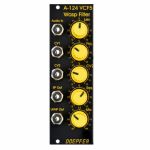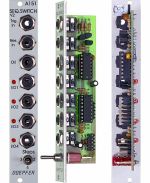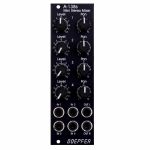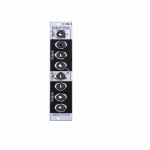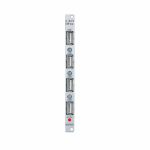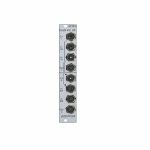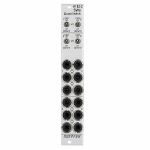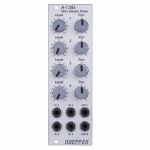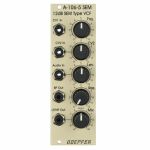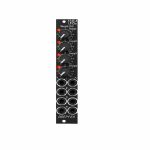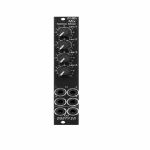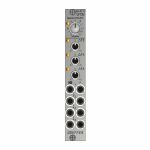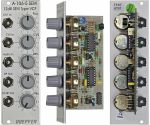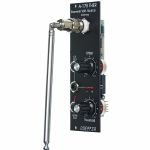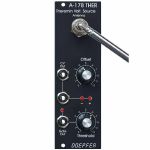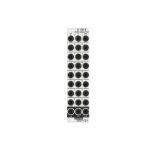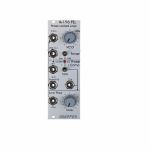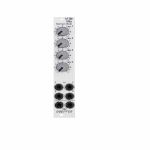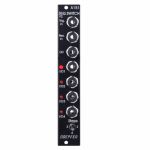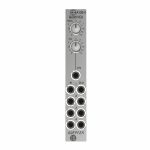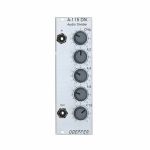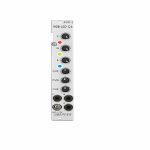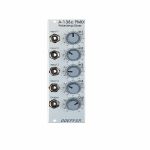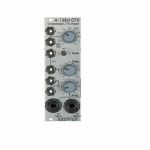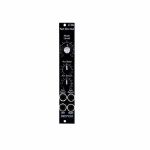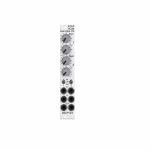100% Sicheres Einkaufen
Studio equipment
Our full range of studio equipment from all the leading equipment and software brands. Guaranteed fast delivery and low prices.
100% Sicheres Einkaufen
DJ equipment
Our full range of DJ equipment from all the leading equipment and software brands. Guaranteed fast delivery and low prices. Visit Juno DJ
Filter
Stock
Coming Soon
Format
Brand
Featured
Price
Tags
Doepfer A-124 VCF5 Wasp Filter 12dB Multimode Filter Module (special edition, black/yellow) (filter synth module)
Cat: 671564 Rel: 29 Nov 17 • View all Synth modules
12dB multi-mode filter with unique classic circuitry, based on the filter from the 70s EDP Wasp synth
Notes: Module A-124 is a special 12dB multimode filter using the "strange" filter circuit of the "EDP Wasp" (an analog synthesizer with black/yellow case built end of the seventies, manufactured by the UK company "Electronic Dream Plant" with Chris Huggett und Adrian Wagner). This design "abuses" digital inverters as analog operational amplifiers leading to distortions and other "dirty" effects that generate the specific sound of this filter. The filter is equipped with a band pass output and a combined low/notch/high pass output. For this output a control knob defines the relation between low and high pass signal. If both signals appear at the same level (i.e. middle position of the Mix knob) one obtains a notch filter. Otherwise the low or high pass signal predominates. The module does not feature self-oscillation in contrast to most of the other filters of the A-100 system.
Inputs: Audio In, CV In (2x)
Outputs: Bandpass Out, Low/Highpass Mix-Out
Controls: Audio and CV attenuator, Frequency, Resonance, LP/HP Mix
The function and operation of this module is very similar to the module SEM VCF A-106-5. But the sound of both filters is very different! The only functional difference is the position of the sockets and controls, and the function of the controls CV2 (A-124: normal attenuator, A-106-5: polarizer).
- 3U Eurorack module, 8HP wide, 45mm deep
- Current draw 30mA
… Read moreInputs: Audio In, CV In (2x)
Outputs: Bandpass Out, Low/Highpass Mix-Out
Controls: Audio and CV attenuator, Frequency, Resonance, LP/HP Mix
The function and operation of this module is very similar to the module SEM VCF A-106-5. But the sound of both filters is very different! The only functional difference is the position of the sockets and controls, and the function of the controls CV2 (A-124: normal attenuator, A-106-5: polarizer).
- 3U Eurorack module, 8HP wide, 45mm deep
- Current draw 30mA
8 in stock $78.88
Click for better price!
or call +44 20 7424 1960
quote 671564
quote 671564
Doepfer A-151 Quad Sequential Switch Module (silver) (switch/quad synth module)
Cat: 577792 Rel: 06 Jun 19 • View all Synth modules
Electronic switch with up to four steps - 4HP
Notes: Module A-151 (Quad Sequential Switch) is like an electronic four-position rotary switch.
It includes trigger and reset inputs, four in / outputs, and a common out / input. Each time a pulse is received at the trigger input socket, the common out / input is connected to the next in / output. After the fourth in / output, the next trigger makes it step back to the first again, and so on. A positive pulse at the reset input switches the out / input immediately back to the first in / output (see Fig. 1). Voltages in the range -8V...+8V at the O/I resp. I/O sockets can be processed by the module.
Four LEDs indicate the active in / output (i.e. the on that is connected to the out / input at any particular time).
… Read moreIt includes trigger and reset inputs, four in / outputs, and a common out / input. Each time a pulse is received at the trigger input socket, the common out / input is connected to the next in / output. After the fourth in / output, the next trigger makes it step back to the first again, and so on. A positive pulse at the reset input switches the out / input immediately back to the first in / output (see Fig. 1). Voltages in the range -8V...+8V at the O/I resp. I/O sockets can be processed by the module.
Four LEDs indicate the active in / output (i.e. the on that is connected to the out / input at any particular time).
4 in stock $58.12
Click for better price!
or call +44 20 7424 1960
quote 577792
quote 577792
Doepfer A-119 External Input Envelope Follower Module (silver) (external/envelope follower/preamp/controller/comparator synth module)
Cat: 577771 Rel: 29 Nov 17 • View all Synth modules
Envelope follower & pre-amplifier for microphone/line-signals - 8HP
Notes: Module A-119 (External Input / Envelope Follower) is designed to allow external audio signals to be integrated into the System A-100. It comprises a pre-amp, envelope follower, and comparator.
The pre-amp has two inputs: an unbalanced input for line level signals, with a gain factor of from 0 to 20, and a balanced input with a gain factor of from 0 to 500, for insertion of low level signals, for instance from a microphone or electric guitar.
The Envelope Follower reads the signal level of the input, and puts out a proportional voltage as an envelope at its own output.
The comparator generates a gate signal whenever the input goes above an adjustable trigger threshold.
Three LED's help you keep track of overload, the envelope, and the gate signal.
… Read moreThe pre-amp has two inputs: an unbalanced input for line level signals, with a gain factor of from 0 to 20, and a balanced input with a gain factor of from 0 to 500, for insertion of low level signals, for instance from a microphone or electric guitar.
The Envelope Follower reads the signal level of the input, and puts out a proportional voltage as an envelope at its own output.
The comparator generates a gate signal whenever the input goes above an adjustable trigger threshold.
Three LED's help you keep track of overload, the envelope, and the gate signal.
5 in stock $67.46
Click for better price!
or call +44 20 7424 1960
quote 577771
quote 577771
Doepfer A-138sv Mini Stereo Mixer Vintage Edition Module (black) (dual/stereo/mixer/panning/quad synth module)
Cat: 684443 Rel: 30 Apr 18 • View all Synth modules
Four-channel stereo mixer - 8HP
Notes: A-138s is a simple but useful 4-in-2 mixing tool. It has four inputs available. Each input is equipped with an attenuator (Level) and a panning control that is used to distribute the signal to the left and right output. Beyond stereo mixing it is equally suited to create variable parallel routings. For example: Any of the four inputs may be routed in variable intensity to feed two filters.
You may regard the A-138s as a smaller version of the A-138m Matrix Mixer.
Inputs and outputs are DC coupled, i.e. the module can be used for the mixing of control signals too.
- 3U Eurorack module, 8 HP wide, 30 mm in depth
- Power consumption: 10 mA at +12 V and 10 mA at -12 V
… Read moreYou may regard the A-138s as a smaller version of the A-138m Matrix Mixer.
Inputs and outputs are DC coupled, i.e. the module can be used for the mixing of control signals too.
- 3U Eurorack module, 8 HP wide, 30 mm in depth
- Power consumption: 10 mA at +12 V and 10 mA at -12 V
4 in stock $85.11
Click for better price!
or call +44 20 7424 1960
quote 684443
quote 684443
Doepfer A-160-2 Clock/Trigger Divider II Module (silver) (clock modulator/frequency divider synth module)
Cat: 671576 Rel: 29 Nov 17 • View all Synth modules
Enhanced clock divider with multiple dividing factors - 4HP
Notes: Module A-160-2 is an enhanced version of the standard clock divider A-160. The module is a frequency divider for clock/trigger/gate signals, designed to be a source of lower frequencies, particularly for rhythm uses. The Clock input will take any digital signal from, eg. LFO, MIDI sync, or the gate from a MIDI-CV interface. At the outputs, you have access to three sets of seven different sub-divided clock signals, from half the clock frequency down to 1/128. The low/high levels of the output signals are 0V and about +10V.
The A-160-2 also has a reset input. Whenever a reset signal is sensed, all outputs are set to certain levels which depend upon the selected mode.
These are the most important features of the module:
Three different sets of dividing factors, selected by a three-position switch at the front panel:
- Power of two: 2, 4, 8, 16, 32, 64, 128
- Prime numbers: 2, 3, 5, 7, 11, 13, 17
- Integer: 2, 3, 4, 5, 6, 7, 8
Two output modes, selected by a two-position switch at the front panel:
- Gate mode: outputs act like the outputs of typical binary dividers
- Trigger mode: in this mode the outputs are AND-wired with the clock signal (i.e. the clock pulsewidth affects the pulsewidth of the outputs)
- Clock edge type selected by a jumper on the pc board:
- Positive: the rising edge of the clock signal triggers the state change of the outputs
- Negative: the falling edge of the clock signal triggers the state change of the outputs
Reset behaviour by two jumpers on the pc board:
- Level triggered: the level at the Reset input triggers the Reset
- Edge triggered: the edge of the signal at the Reset input triggers the Reset
- Positive: a high level (> 2.5V) or the rising edge at the Reset input triggers the Reset
- Negative: a low level (< 1 V) or the falling edge at the Reset input triggers the Reset
Output polarity selected by a jumper on the pc board:
- Positive: non-inverted outputs
- Negative: all seven outputs are inverted
Width: 4HP / 20mm
Depth: 35mm (Measured from the rear side of the front panel)
Current: +12V: +50mA, -12V: -0mA
… Read moreThe A-160-2 also has a reset input. Whenever a reset signal is sensed, all outputs are set to certain levels which depend upon the selected mode.
These are the most important features of the module:
Three different sets of dividing factors, selected by a three-position switch at the front panel:
- Power of two: 2, 4, 8, 16, 32, 64, 128
- Prime numbers: 2, 3, 5, 7, 11, 13, 17
- Integer: 2, 3, 4, 5, 6, 7, 8
Two output modes, selected by a two-position switch at the front panel:
- Gate mode: outputs act like the outputs of typical binary dividers
- Trigger mode: in this mode the outputs are AND-wired with the clock signal (i.e. the clock pulsewidth affects the pulsewidth of the outputs)
- Clock edge type selected by a jumper on the pc board:
- Positive: the rising edge of the clock signal triggers the state change of the outputs
- Negative: the falling edge of the clock signal triggers the state change of the outputs
Reset behaviour by two jumpers on the pc board:
- Level triggered: the level at the Reset input triggers the Reset
- Edge triggered: the edge of the signal at the Reset input triggers the Reset
- Positive: a high level (> 2.5V) or the rising edge at the Reset input triggers the Reset
- Negative: a low level (< 1 V) or the falling edge at the Reset input triggers the Reset
Output polarity selected by a jumper on the pc board:
- Positive: non-inverted outputs
- Negative: all seven outputs are inverted
Width: 4HP / 20mm
Depth: 35mm (Measured from the rear side of the front panel)
Current: +12V: +50mA, -12V: -0mA
2 in stock $97.56
Click for better price!
or call +44 20 7424 1960
quote 671576
quote 671576
Doepfer A-180-3 Dual Buffered Multiple Module (silver) (dual/stereo/multiple synth module)
Cat: 751720 Rel: 23 Oct 19 • View all Synth modules
Dual buffered 1-in-3 multiple module - 4HP
Notes: Module A-180-3 is a dual buffered 1-in-3 multiple. The signal applied to the input socket appears as a buffered signal at the three output sockets. Each output has its own buffer, i.e. the three output sockets are not simply connected to each other. The lower output of the upper unit is normalled in the factory to the input of the lower unit. That way the module works as a single 1-in-6 buffered multiple provided that no signal is applied to the input of the lower unit. But it's also possible to pick-up the bus CV and normalize the input socket of the lower unit to the bus CV.
Application: copying/buffering of CV, gate and audio signals.
… Read moreApplication: copying/buffering of CV, gate and audio signals.
out of stock $51.89
Doepfer A-125 VCP Voltage Controlled Phase Shifter Module (effect/phase shifter synth module)
Cat: 707078 Rel: 23 Oct 18 • View all Synth modules
Classic voltage controlled phase shifter - 8HP
Notes: Module A-125 (VC Phaser) is a voltage controlled phase shifter. Phase shifting can be controlled either manually or by voltage control. Other parameters which can be controlled are resonance (governing the depth of the comb filtering, and tonal colour) and mix (the amount of the original signal which is added to the phase-shifted signal). The A-125 is used to generate the typical phaser sound ("jet sound"). Due to the voltage control feature not only the usual LFO-controlled phasings but even ADSR-, random-, sequencer- or S&H-controlled phasings are possible. In combination with the Shepard generator A-191 and several A-125 never ending barberpole phasing effects come true.
… Read moreout of stock $78.30
Doepfer A-183-9 Quad USB Power Supply Module (power/quad/utility synth module)
Cat: 711015 Rel: 29 Nov 18 • View all Synth modules
Simple power supply for up to four devices - 2HP
Notes: Module A-183-9 is a simple power supply for up to four devices which can be powered via USB (e.g. keyboards, smartphones). An LED shows is the +5V are present.
The module has no USB function but provides only the +5V supply for USB devices.
A control LED shows if the +5V are present.
Note: The module requires an A-100 case with built in power supply A-100PSU3. Only this A-100 supply has the required +5V available. We do not recommend the usage of an older A-100 case with A-100PSU2 as this would require the +5V adapter A-100AD5 and the max. current would be limited to 100mA.
… Read moreThe module has no USB function but provides only the +5V supply for USB devices.
A control LED shows if the +5V are present.
Note: The module requires an A-100 case with built in power supply A-100PSU3. Only this A-100 supply has the required +5V available. We do not recommend the usage of an older A-100 case with A-100PSU2 as this would require the +5V adapter A-100AD5 and the max. current would be limited to 100mA.
5 in stock $51.89
Click for better price!
or call +44 20 7424 1960
quote 711015
quote 711015
Doepfer A-134-2 Dual Voltage Controlled Crossfader Module (VCA/dual/stereo/panning synth module)
Cat: 716922 Rel: 29 Jan 19 • View all Synth modules
Dual crossfader module for voltage controlled morphing between two audio or CV signals
Notes: Module A-134-2 contains two identical voltage controlled crossfader units.
Each unit has two voltage controlled amplifiers (VCAs) with opposite control behaviour available. The outputs of the two VCAs are mixed together to obtain a common output. The behaviour of the control voltage inputs can be chosen with an internal jumper:
Symmetrical mode: If the corresponding jumper is not set both VCAs of the crossfader have the same 50% amplification with zero CV. If the applied CV becomes positive the amplification of VCA1 decreases and those of VCA2 increases in the same way. A negative CV has the opposite result. The CV voltage range to obtain the maximum/minimum positions of the crossfader is about -2.5....+2.5V. This mode is useful for bidirectional (i.e. positive and negative) control voltages, for example LFO or joy stick (adjusted to 0V CV in centre position).
Asymmetrical mode: If the corresponding jumper is set VCA2 is fully closed and VCA1 has full 100% amplification with zero CV. If the applied CV becomes positive the amplification of VCA1 decreases and those of VCA2 increases in the same way. The CV voltage range to obtain the maximum/minimum positions of the crossfader is about 0...+5V. A negative CV has no function in this mode. This mode is useful for unidirectional (i.e. only positive) control voltages, for example ADSR, ribbon controller or Theremin control voltage.
The CV input of the upper unit (CV1) is normalled to the CV input of the lower unit (CV2). I.e. if no plug is inserted to CV2 the CV input of the upper unit (CV1) also controls the lower unit.
The second signal input of the upper unit (In1B) is normalled to the first signal input of the lower unit (In2A). I.e. if no plug is inserted into In2A the signal In1B is used as the first signal input of the second unit.
As the inputs and outputs are DC coupled the module can be used for both audio and control voltage signal processing.
… Read moreEach unit has two voltage controlled amplifiers (VCAs) with opposite control behaviour available. The outputs of the two VCAs are mixed together to obtain a common output. The behaviour of the control voltage inputs can be chosen with an internal jumper:
Symmetrical mode: If the corresponding jumper is not set both VCAs of the crossfader have the same 50% amplification with zero CV. If the applied CV becomes positive the amplification of VCA1 decreases and those of VCA2 increases in the same way. A negative CV has the opposite result. The CV voltage range to obtain the maximum/minimum positions of the crossfader is about -2.5....+2.5V. This mode is useful for bidirectional (i.e. positive and negative) control voltages, for example LFO or joy stick (adjusted to 0V CV in centre position).
Asymmetrical mode: If the corresponding jumper is set VCA2 is fully closed and VCA1 has full 100% amplification with zero CV. If the applied CV becomes positive the amplification of VCA1 decreases and those of VCA2 increases in the same way. The CV voltage range to obtain the maximum/minimum positions of the crossfader is about 0...+5V. A negative CV has no function in this mode. This mode is useful for unidirectional (i.e. only positive) control voltages, for example ADSR, ribbon controller or Theremin control voltage.
The CV input of the upper unit (CV1) is normalled to the CV input of the lower unit (CV2). I.e. if no plug is inserted to CV2 the CV input of the upper unit (CV1) also controls the lower unit.
The second signal input of the upper unit (In1B) is normalled to the first signal input of the lower unit (In2A). I.e. if no plug is inserted into In2A the signal In1B is used as the first signal input of the second unit.
As the inputs and outputs are DC coupled the module can be used for both audio and control voltage signal processing.
1 in stock $72.65
Click for better price!
or call +44 20 7424 1960
quote 716922
quote 716922
Doepfer A-182-2 Quad Passive Switch Slim Line Series Module (silver) (quad/switch synth module)
Cat: 731951 Rel: 11 Jun 19 • View all Synth modules
Quad passive switch - 4HP
Notes: A-182-2 is a simple passive module that contains four changeover switches, which are used to connect or disconnect the sockets of the corresponding socket triplet:
- In the upper position of the switch the upper socket of the corresponding socket triplet is connected to the centre socket
- In the lower position of the switch the lower socket of the corresponding socket triplet is connected to the centre socket
- In the centre position of the switch the sockets are not connected
Each unit of the module can be used to switch between two signals or to interrupt/connect a signal. In the last case the third socket of the triplet is not used.
The module is fully passive and both audio or control signals can be switched.
… Read more- In the upper position of the switch the upper socket of the corresponding socket triplet is connected to the centre socket
- In the lower position of the switch the lower socket of the corresponding socket triplet is connected to the centre socket
- In the centre position of the switch the sockets are not connected
Each unit of the module can be used to switch between two signals or to interrupt/connect a signal. In the last case the third socket of the triplet is not used.
The module is fully passive and both audio or control signals can be switched.
out of stock $62.26
Doepfer A-138s Mini Stereo Mixer Module (silver) (mixer/panning/dual/stereo/quad synth module)
Cat: 671589 Rel: 29 Nov 17 • View all Synth modules
Four-channel stereo mixer - 8HP
Notes: A-138s is a simple but useful 4-in-2 mixing tool. It has four inputs available. Each input is equipped with an attenuator (Level) and a panning control that is used to distribute the signal to the left and right output. Beyond stereo mixing it is equally suited to create variable parallel routings. For example: Any of the four inputs may be routed in variable intensity to feed two filters.
You may regard the A-138s as a smaller version of the A-138m Matrix Mixer.
Inputs and outputs are DC coupled, i.e. the module can be used for the mixing of control signals too.
- 3U Eurorack module, 8 HP wide, 30 mm in depth
- Power consumption: 10 mA at +12 V and 10 mA at -12 V
… Read moreYou may regard the A-138s as a smaller version of the A-138m Matrix Mixer.
Inputs and outputs are DC coupled, i.e. the module can be used for the mixing of control signals too.
- 3U Eurorack module, 8 HP wide, 30 mm in depth
- Power consumption: 10 mA at +12 V and 10 mA at -12 V
1 in stock $77.83
Doepfer A-106-5 SEM 12dB SEM Type VCF Special Edition Module (cream) (filter synth module)
Cat: 671592 Rel: 29 Nov 17 • View all Synth modules
12dB multi-mode filter based on classic SEM filter circuitry
Notes: Module A-106-5 is a 12dB multimode filter that is based on the filter circuit of the Oberheim SEM module. The filter is equipped with a band pass output and a combined low/notch/high pass output. For this output a control knob defines the relation between low and high pass signal. If both signals appear at the same level (i.e. middle position of the Mix knob) one obtains a notch filter. Otherwise the low or high pass signal predominates. The module does not feature self oscillation in contrast to most of the other filters of the A-100 system. The module generates a distorted audio signal if the level control is set to about 50% (i.e. centre position) or more with A-100 standard signals like VCOs.
Inputs: Audio In, CV1 In without attenuator, CV2 In with Polarizer
Outputs: Bandpass Out, Low/Highpass Mix-Out
Controls: Audio Attenuator, CV2 Polarizer, Frequency, Resonance, LP/HP Mix
The function and operation of this module is very similar to the Wasp filter module A-124. But the sound of both filters is very different! We will publish no separate user's manual for the A-106-5 but a combined manual for both A-106-5 and A-124. The only functional difference is the position of the sockets and controls, and the function of the controls CV2 (A-124: normal attenuator, A-106-5: polarizer)
Width: 8HP / 40.3mm
Depth: 55mm (Measured from the rear side of the front panel)
Current: +12V: +30mA, -12V: -20mA
… Read moreInputs: Audio In, CV1 In without attenuator, CV2 In with Polarizer
Outputs: Bandpass Out, Low/Highpass Mix-Out
Controls: Audio Attenuator, CV2 Polarizer, Frequency, Resonance, LP/HP Mix
The function and operation of this module is very similar to the Wasp filter module A-124. But the sound of both filters is very different! We will publish no separate user's manual for the A-106-5 but a combined manual for both A-106-5 and A-124. The only functional difference is the position of the sockets and controls, and the function of the controls CV2 (A-124: normal attenuator, A-106-5: polarizer)
Width: 8HP / 40.3mm
Depth: 55mm (Measured from the rear side of the front panel)
Current: +12V: +30mA, -12V: -20mA
out of stock $78.88
Doepfer A-148 Dual Sample & Hold - Track & Hold Module (silver) (CV modulation/sample & hold/dual/stereo synth module)
Cat: 577745 Rel: 29 Nov 17 • View all Synth modules
Two sample & hold units in one module for generating stepped random voltages or slicing signals
Notes: Module A-148 (Dual S&H) has two identical sample & hold modules, designed to produce 'staircase' voltages. The signal present at the sample input is sampled at a rate set by the signal at the trigger input, and held at that voltage at the S&H output.
The exact shape of the staircase depends on the sort of waveform at the sample input: NOISE or RANDOM signals produce random patterns; an LFO produces rising or falling staircase patterns.
Two LEDs for each S&H indicate the voltage (positive or negative) of the sampled signal.
… Read moreThe exact shape of the staircase depends on the sort of waveform at the sample input: NOISE or RANDOM signals produce random patterns; an LFO produces rising or falling staircase patterns.
Two LEDs for each S&H indicate the voltage (positive or negative) of the sampled signal.
1 in stock $66.42
Click for better price!
or call +44 20 7424 1960
quote 577745
quote 577745
Doepfer A-145-4v Quad LFO Low Frequency Oscillator Vintage Edition Module (black) (quad/LFO synth module)
Cat: 760210 Rel: 01 Apr 20 • View all Synth modules
Notes: Module A-145-4 is a simple quad LFO (Low Frequency Oscillator). Not a very "exciting" module, just a bread-and-butter device and a simple demon for work. Virtually in every modular system several LFOs are required for modulation purposes. The module contains four simple LFOs with the waveforms triangle and rectangle. A dual colour LED (red = positive / yellow = negative output voltage) indicates the triangle output of each LFO. The frequency range can be chosen for each LFO individually by means of a jumper between about 50 Hz ... 0.04 Hz (about 20 seconds, jumper removed) and about 2Hz ... 0.002 (about 8 minutes, jumper installed).
The module can be treated as a slimmed version of the quad LFO A-143-3 as it has similar features available. But the distances between the controls are smaller and rubberized small-sized knobs are used. In return the front panel has 4 HP only which is less than one third of the A-143-3. The module is primarily planned for applications where only limited space is available. The functional difference compared to the A-143-3 are the missing sawtooth outputs and frequency range switches.
… Read moreThe module can be treated as a slimmed version of the quad LFO A-143-3 as it has similar features available. But the distances between the controls are smaller and rubberized small-sized knobs are used. In return the front panel has 4 HP only which is less than one third of the A-143-3. The module is primarily planned for applications where only limited space is available. The functional difference compared to the A-143-3 are the missing sawtooth outputs and frequency range switches.
2 in stock $89.25
Click for better price!
or call +44 20 7424 1960
quote 760210
quote 760210
Doepfer A-138nv Narrow Mini Mixer Vintage Edition Module (black) (mixer/quad synth module)
Cat: 760211 Rel: 06 Mar 20 • View all Synth modules
Narrow mini mixer module - 4HP.
Notes: Compact and simple four-input mixer module from Uncle Dieter. Linear pots make it suited to mixing CV signals but it can also handle audio. Mixed signal hard-wired to two sockets.
Supplier notes:
Module A-138n is a simple four channel mixer, which can be used with either control voltages or audio signals. Each of the four inputs has an attenuator available. The output is twice available (two sockets, hard-wired like a multiple).
HP : 4
… Read moreSupplier notes:
Module A-138n is a simple four channel mixer, which can be used with either control voltages or audio signals. Each of the four inputs has an attenuator available. The output is twice available (two sockets, hard-wired like a multiple).
HP : 4
1 in stock $63.10
Doepfer A-147-5 Quad VCLFO Module (silver) (B-STOCK) (LFO synth module)
Cat: 991895 Rel: 01 Jan 90 • View all Synth modules
B-STOCK: Box opened, but product is in excellent condition and in perfect working order
Notes: ***B-STOCK: Box opened, but product is in excellent condition and in perfect working order***
Module A-147-5 contains four voltage controlled low frequency oscillators (VCLFO) with triangle waveform outputs. All LFOs share a common frequency control. Each of the LFOs 2, 3 features a Delta control which is used to shift the frequency of the LFO in question up or down. With the Delta controls at center positions the frequencies of all LFOs are roughly the same. To control the frequencies by external control voltages four CV inputs are available which follow roughly the 1V/oct standard.
The module has these controls and in/outputs available:
Control F: manual control of the frequency for all four LFOs
Control Delta F2, F3 and F4: manual control of the frequency shift up/down for the LFO in question
Sockets CV 1...4: Frequency control voltage inputs (normalled from top to bottom)
Sockets with triangle symbol 1...4: triangle outputs
LEDs: visual displays of the triangle outputs (red = positive, yellow = negative output voltage)
Application examples:
Generation of four triangle modulation signals with a common frequency control for all LFOs and individual controls for the frequency deviation of each LFO, manually adjustable and controllable by external control voltages
Generation of modulation signals for polyphonic FM/PWM applications. For this the four CV inputs are connected to the same control voltages which are used to control the frequencies of the corresponding VCOs. That way each LFO follows the frequency of the associated VCO with the possibility to control the frequency of all VCOs (control F) and the frequency deviations (Delta F controls). For the simultaneous modulation depth control the Quad VCA module A-130-4 is recommended.
Generation of complex modulation signals by summing up the outputs (e.g. by means of a mixer module A-138n / A-138i / A-138j)
Technical notes:
The level of the triangle outputs is about +/-5V (10Vpp)
The manually adjustable frequency ranges from about 0.025 Hz (about 40 seconds) to about 50 Hz with the delta controls of LFOs 2, 3 and 4 about center position
The frequency deviations adjusted by the delta controls are about +/-1:5. Example: with 1 Hz in center position the frequency shift ranges from about 0.2 Hz in position -5 to about 5 Hz in position +5 (1 Hz/5 = 0.2 Hz, 1 Hz*5 = 5 Hz).
The manual frequency controls and the control voltage inputs have an exponential control behavior
With external control voltage the max. frequency is about 150 Hz, the minimum frequency
The scale of the CV inputs is roughly 1V/oct (not adjustable)
The CV inputs are normalled from top to bottom. Provided that only socket CV1 is patched CV1 controls the frequencies of all four LFOs.
When each CV input is patched to it's own control voltage each LFO is controlled individually by it's own CV. In this case CV1 controls only the frequency of LFO1.
Internally the rectangle outputs are available at four terminals (typ level +/-10V or 20Vpp). If required they can be wired to four sockets of a DIY breakout module made by the user, 1k protection resistors are recommended to avoid short circuits. If lower levels are required passive attenuators (voltage dividers) may be used.
Internally is even an (unbufferd) triangle sum signal available. For this each of the four triangle outputs is simply connected to the sum output terminal via a 47k resistor. This output has high impedance and should be buffered or amplified to avoid level drop when the load changes (e.g. by means of an A-180-3 or A-180-4 or A-183-3).
By changing the values of the capacitors in the LFO circuits even other frequency ranges are possible (e.g. Quad VCO to form kind of a cloud VCO). Pay attention that the accuracy of the CV input scales is not sufficient for precise 1V/oct VCO applications. The 1V/Oct scales cannot be adjusted and the circuits are not temperature compensated.
Dimensions
4 HP
45 mm deep
… Read moreModule A-147-5 contains four voltage controlled low frequency oscillators (VCLFO) with triangle waveform outputs. All LFOs share a common frequency control. Each of the LFOs 2, 3 features a Delta control which is used to shift the frequency of the LFO in question up or down. With the Delta controls at center positions the frequencies of all LFOs are roughly the same. To control the frequencies by external control voltages four CV inputs are available which follow roughly the 1V/oct standard.
The module has these controls and in/outputs available:
Control F: manual control of the frequency for all four LFOs
Control Delta F2, F3 and F4: manual control of the frequency shift up/down for the LFO in question
Sockets CV 1...4: Frequency control voltage inputs (normalled from top to bottom)
Sockets with triangle symbol 1...4: triangle outputs
LEDs: visual displays of the triangle outputs (red = positive, yellow = negative output voltage)
Application examples:
Generation of four triangle modulation signals with a common frequency control for all LFOs and individual controls for the frequency deviation of each LFO, manually adjustable and controllable by external control voltages
Generation of modulation signals for polyphonic FM/PWM applications. For this the four CV inputs are connected to the same control voltages which are used to control the frequencies of the corresponding VCOs. That way each LFO follows the frequency of the associated VCO with the possibility to control the frequency of all VCOs (control F) and the frequency deviations (Delta F controls). For the simultaneous modulation depth control the Quad VCA module A-130-4 is recommended.
Generation of complex modulation signals by summing up the outputs (e.g. by means of a mixer module A-138n / A-138i / A-138j)
Technical notes:
The level of the triangle outputs is about +/-5V (10Vpp)
The manually adjustable frequency ranges from about 0.025 Hz (about 40 seconds) to about 50 Hz with the delta controls of LFOs 2, 3 and 4 about center position
The frequency deviations adjusted by the delta controls are about +/-1:5. Example: with 1 Hz in center position the frequency shift ranges from about 0.2 Hz in position -5 to about 5 Hz in position +5 (1 Hz/5 = 0.2 Hz, 1 Hz*5 = 5 Hz).
The manual frequency controls and the control voltage inputs have an exponential control behavior
With external control voltage the max. frequency is about 150 Hz, the minimum frequency
The scale of the CV inputs is roughly 1V/oct (not adjustable)
The CV inputs are normalled from top to bottom. Provided that only socket CV1 is patched CV1 controls the frequencies of all four LFOs.
When each CV input is patched to it's own control voltage each LFO is controlled individually by it's own CV. In this case CV1 controls only the frequency of LFO1.
Internally the rectangle outputs are available at four terminals (typ level +/-10V or 20Vpp). If required they can be wired to four sockets of a DIY breakout module made by the user, 1k protection resistors are recommended to avoid short circuits. If lower levels are required passive attenuators (voltage dividers) may be used.
Internally is even an (unbufferd) triangle sum signal available. For this each of the four triangle outputs is simply connected to the sum output terminal via a 47k resistor. This output has high impedance and should be buffered or amplified to avoid level drop when the load changes (e.g. by means of an A-180-3 or A-180-4 or A-183-3).
By changing the values of the capacitors in the LFO circuits even other frequency ranges are possible (e.g. Quad VCO to form kind of a cloud VCO). Pay attention that the accuracy of the CV input scales is not sufficient for precise 1V/oct VCO applications. The 1V/Oct scales cannot be adjusted and the circuits are not temperature compensated.
Dimensions
4 HP
45 mm deep
out of stock $92.95
Doepfer A-106-5 SEM 12dB SEM Type VCF Module (silver) (filter synth module)
Cat: 577753 Rel: 06 Jun 19 • View all Synth modules
12dB multi-mode filter - 8HP
Notes: Module A-106-5 is a 12dB multimode filter that is based on the filter circuit of the Oberheim SEM module.
The filter is equipped with a band pass output and a combined low/notch/high pass output. For this output a control knob defines the relation between low and high pass signal. If both signals appear at the same level (i.e. middle position of the Mix knob) one obtains a notch filter. Otherwise the low or high pass signal predominates.
The module does not feature self-oscillation in contrast to most of the other filters of the A-100 system.
The module generates a distorted audio signal if the level control is set to about 50% (i.e. centre position) or more with A-100 standard signals like VCOs.
… Read moreThe filter is equipped with a band pass output and a combined low/notch/high pass output. For this output a control knob defines the relation between low and high pass signal. If both signals appear at the same level (i.e. middle position of the Mix knob) one obtains a notch filter. Otherwise the low or high pass signal predominates.
The module does not feature self-oscillation in contrast to most of the other filters of the A-100 system.
The module generates a distorted audio signal if the level control is set to about 50% (i.e. centre position) or more with A-100 standard signals like VCOs.
out of stock $86.14
Doepfer A-178v Theremin Control Voltage Source Vintage Edition Module (black) (controller/CV modulation/utility synth module)
Cat: 852800 Rel: 05 Jan 22 • View all Synth modules
Theremin module for generating a variable control voltage by approaching/removing hand to/from an antenna.
Notes: Theremin module for generating a variable control voltage by approaching/removing hand to/from an antenna.
The distance range is about 30 cm. Additionally the module is equipped with a Gate output with adjustable threshold level. To simulate the original Theremin two A-178, a VCO (e.g. A-110) and a linear VCA (e.g. A-130 or A-132) are required. But of course the A-178 can be used to control other functions in the A-100 (e.g. filter frequency, modulation depth and/or speed, tempo, attack/decay time and so on).
The CV output voltage of the A-178 can range - according to the setting of the front panel controls - from -10V...+10V.
The gate output switches from 0V to about +10V.
Power consumption: 60mA at +12V and 20mA at -12V
Depth: 40mm
HP : 8
… Read moreThe distance range is about 30 cm. Additionally the module is equipped with a Gate output with adjustable threshold level. To simulate the original Theremin two A-178, a VCO (e.g. A-110) and a linear VCA (e.g. A-130 or A-132) are required. But of course the A-178 can be used to control other functions in the A-100 (e.g. filter frequency, modulation depth and/or speed, tempo, attack/decay time and so on).
The CV output voltage of the A-178 can range - according to the setting of the front panel controls - from -10V...+10V.
The gate output switches from 0V to about +10V.
Power consumption: 60mA at +12V and 20mA at -12V
Depth: 40mm
HP : 8
1 in stock $96.51
Doepfer A-130-8 Octal Linear VCA/Voltage Controlled Mixers Slim Line Series Module (silver) (mixer/Quad/VCA synth module)
Cat: 765896 Rel: 28 Jul 20 • View all Synth modules
linear VCA module
Notes: Lots of functionality in a compact format thanks to Doepfer's typically smart approach. Eight linear VCAs with three mixers built in for good measure. Can be used for both audio and CV signals. Versatile.
Supplier notes:
Module A-130-8 contains eight linear voltage controlled amplifiers (VCAs). Each VCA features a control voltage input (CV), a signal input (In) and a signal output (Out). In addition three mixers are included: the socket labelled "1-4" outputs the sum of the VCAs 1-4, the socket labelled "5-8" outputs the sum of the VCAs 5-8, the socket labelled "1-8" outputs the sum of all eight VCAs.
The signal inputs are able to process levels up to 10Vpp without clipping. Each CV input is equipped with a trimming potentiometer that is used to adjust the sensitivity of the CV input in question. In the factory the module is adjusted for the CV range 1...+5V but can be re-adjusted by the user for other control voltage ranges (e.g. 0...+10V).
The amplification range for each single VCA is 0...1. The signals of the sum outputs have a lower amplification to avoid distortion.
The VCAs and mixers are fully DC coupled, i.e. the module can be used for the processing of both audio and control voltage signals. The control voltage and signal inputs can be normalled by means of small solder pads (e.g. 1 > 2 > 3 > 4 and so on, or 1 > 5, 2 > 6, 3 > 7, 4 > 8 for the stereo application mentioned below).
Typical applications:
any kind of VCA application (e.g. voltage controlled attenuation of audio or control voltage signals)
two voltage controlled mixers with four channels each
voltage controlled stereo mixer with four channels each, for this the control voltage inputs have to be correspondingly patched or internally normalled: CV1=CV5 /CV 2=CV6 / CV3=CV7 / CV4=CV8
voltage controlled mixer with eight channels
add-on for the planned Joystick module A-174-4
HP : 6
… Read moreSupplier notes:
Module A-130-8 contains eight linear voltage controlled amplifiers (VCAs). Each VCA features a control voltage input (CV), a signal input (In) and a signal output (Out). In addition three mixers are included: the socket labelled "1-4" outputs the sum of the VCAs 1-4, the socket labelled "5-8" outputs the sum of the VCAs 5-8, the socket labelled "1-8" outputs the sum of all eight VCAs.
The signal inputs are able to process levels up to 10Vpp without clipping. Each CV input is equipped with a trimming potentiometer that is used to adjust the sensitivity of the CV input in question. In the factory the module is adjusted for the CV range 1...+5V but can be re-adjusted by the user for other control voltage ranges (e.g. 0...+10V).
The amplification range for each single VCA is 0...1. The signals of the sum outputs have a lower amplification to avoid distortion.
The VCAs and mixers are fully DC coupled, i.e. the module can be used for the processing of both audio and control voltage signals. The control voltage and signal inputs can be normalled by means of small solder pads (e.g. 1 > 2 > 3 > 4 and so on, or 1 > 5, 2 > 6, 3 > 7, 4 > 8 for the stereo application mentioned below).
Typical applications:
any kind of VCA application (e.g. voltage controlled attenuation of audio or control voltage signals)
two voltage controlled mixers with four channels each
voltage controlled stereo mixer with four channels each, for this the control voltage inputs have to be correspondingly patched or internally normalled: CV1=CV5 /CV 2=CV6 / CV3=CV7 / CV4=CV8
voltage controlled mixer with eight channels
add-on for the planned Joystick module A-174-4
HP : 6
out of stock $97.82
Doepfer A-185-2v Precision Adder/Bus Access Vintage Edition Module (black) (attenuator/CV modulation/mixer/multiple/utility synth module)
Cat: 751764 Rel: 23 Oct 19 • View all Synth modules
Precision adder (mixer) and buffer for control voltages - 6HP
Notes: Module A-185-2 is a precision control voltage adder/buffer. Precision means that the amplification of the inputs without attenuators is exactly 1.00 and is suitable to add control voltages for the pitch control of VCOs (e.g. from keyboard + sequencer 1 + sequencer 2). Summing resistors matched to 0.1% are used to obtain an accuracy of 0.1% for the added voltages.
The module is equipped with four CV inputs: one with attenuator and three without attenuator. Each input is normalled to +1 V (i.e. if no plug is inserted the input contributes 1 V to the sum appearing at the output).
The input with attenuator can be used for common modulations (e.g. from an LFO, ADSR, Theremin, Pitch-Bender) for all VCOs connected to the output. The Lev.1 control is used to adjust the depth of the modulation, the first switch selects the polarity of the modulation. If no signal is connected to the first socket the attenuator works as a (fine) tuning knob because a voltage in the range 0...+1V (right position of the switch) or 0...-1V (left position of the switch) is added to the CV output.
The inputs without attenuators are planned to add control voltages coming out of keyboards, sequencers, Midi-to-CV interfaces, ribbon controllers or other CV sources that follow the 1V/oct standard. For example the CV of a keyboard can be used to transpose the CV coming from a sequencer, or the CV of a slow sequencer can be used to transpose the CV from a fast sequencer.
Each input is equipped with a three-position switch that determines if the corresponding voltage is added (right position), subtracted (left position) or if the input has no effect (centre position). If no plug is inserted the corresponding switch works as an octave switch for the lower three sections as the default 1 V are added or subtracted to the output voltage according to the switch position. The first switch can be used to add a variable voltage to the sum output. The variable voltage is adjusted with the Lev.1 control and the knob works then as kind of a (fine) tuning control.
The module is equipped with 4 outputs: three non-inverting and one inverting ouput. An internal jumper can be used to connect the non-inverted or inverted output to the CV line of the A-100 bus. That way the module can used to control several VCOs that are connected to the same bus board as the A-185-2 (same functionality as A-185-1).
… Read moreThe module is equipped with four CV inputs: one with attenuator and three without attenuator. Each input is normalled to +1 V (i.e. if no plug is inserted the input contributes 1 V to the sum appearing at the output).
The input with attenuator can be used for common modulations (e.g. from an LFO, ADSR, Theremin, Pitch-Bender) for all VCOs connected to the output. The Lev.1 control is used to adjust the depth of the modulation, the first switch selects the polarity of the modulation. If no signal is connected to the first socket the attenuator works as a (fine) tuning knob because a voltage in the range 0...+1V (right position of the switch) or 0...-1V (left position of the switch) is added to the CV output.
The inputs without attenuators are planned to add control voltages coming out of keyboards, sequencers, Midi-to-CV interfaces, ribbon controllers or other CV sources that follow the 1V/oct standard. For example the CV of a keyboard can be used to transpose the CV coming from a sequencer, or the CV of a slow sequencer can be used to transpose the CV from a fast sequencer.
Each input is equipped with a three-position switch that determines if the corresponding voltage is added (right position), subtracted (left position) or if the input has no effect (centre position). If no plug is inserted the corresponding switch works as an octave switch for the lower three sections as the default 1 V are added or subtracted to the output voltage according to the switch position. The first switch can be used to add a variable voltage to the sum output. The variable voltage is adjusted with the Lev.1 control and the knob works then as kind of a (fine) tuning control.
The module is equipped with 4 outputs: three non-inverting and one inverting ouput. An internal jumper can be used to connect the non-inverted or inverted output to the CV line of the A-100 bus. That way the module can used to control several VCOs that are connected to the same bus board as the A-185-2 (same functionality as A-185-1).
out of stock $81.99
Doepfer A-196 PLL Phase Locked Loop Module (filter/oscillator/effect synth module)
Cat: 755416 Rel: 14 Nov 19 • View all Synth modules
Eurorack phase locked loop module, featuring voltage-controlled oscillator, phase comparator & low pass filter
Notes: Module A-196 contains a so-called phase locked loop (PLL). The basic PLL system is shown in the sketch at the bottom of this page. A PLL consists of three parts: voltage-controlled oscillator (VCO), phase comparator (PC), and low-pass filter (LPF). All parts are normally connected to form a closed-loop frequency-feedback system.
This is how a PLL works: The output of the internal VCO (linear CV control, rectangle output) is compared with an external signal (e.g. the rectangle output of a A-110 VCO) in the so-called phase comparator (PC). The output of the phase comparator is a digital signal (low/high/tristate) that indicates if the frequency resp. phase difference of the two input signals is negative, zero or positive. The output of the phase comparator is processed by a low pass filter (LPF) to generate a smooth voltage that is used to control the frequency of the internal VCO. The 3 units VCO, PC and LPF form a feedback loop that works like this: The control voltage (output of the LPF) increases as long as the external frequency is higher than the frequency of the internal VCO und stops increasing when both frequencies become identical. The control voltage decreases as long as the external frequency is lower than the frequency of the internal VCO und stops decreasing when both frequencies become identical.
But there are some stumbling blocks: Different types of phase comparators with advantages and disadvantages can be made. Some phase comparators e.g. even lock at harmonics, i.e. if the two frequencies to be compared are integer multiples. But for some applications this can be used to create interesting effects. The A-196 contains 3 different types of phase comparators: PC1 is a simple exclusive OR, that even locks at harmonics. PC2 is a so-called RS flipflop and PC3 a more complex digital memory network. The user can select one of the three phase comparators with a 3-position switch. When PC2 is used a LED displays the "locked" state, i.e. when the frequency of the internal VCO is identical to the external frequency.
Special attention has to be directed to the frequency of the LPF. To obtain a smooth control voltage for the VCO the frequency of the LPF has to be much smaller than the lowest frequency of the internal or external audio signal. Otherwise the frequency of the internal VCO will jitter or wobble around the correct frequency. But for special effects this frequency jitter can be used intentionally. Example: frequencies in the range 50Hz...1kHz have to be processed with the PLL. Therefore the frequency of the LPF has to be about 10Hz or even less. Such a low frequency of the LPF causes a noticeable slew of the internal VCO. When the frequency of the external signal jumps e.g. between 500Hz and 1kHz it takes about 0.1 second until the internal VCO reaches the new frequency (like portamento). So one has to find a compromise between frequency jitter and portamento. But these remarks are valid only for the "ideal" working PLL. As the A-196 is used in a musical environment the "problems" and disadvantages with jitter and slew time lead to additional musical applications like portamento effects, wobbling frequencies or harmonic locking according to the type of frequency comparator and time constant of the PLL low pass filter. Instead of the internal manually controlled low pass filter the voltage controlled slew limiter A-171 can be used to obtain voltage control of this parameter. Normal audio filters (e.g. A-120, A-121) cannot be used for this job as the minimum frequency is to high (down to a few Hz or even less necessary) and the signal has to be DC coupled due to the low frequencies. Audio filters are normally AC coupled.
Another very important application of a PLL is frequency multiplication in combination with an external frequency divider. For this the output of the PLL-VCO is processed through an external frequency divider (e.g. A-163, A-160, A-161, A-115) before it is fed to In1 of the phase comparator. In this case the frequency of the PLL-VCO will be a multiple of the master frequency. E.g. if the A-163 is used and adjusted to dividing factor 5 the frequency of the PLL-VCO will be 5 times the frequency of the master VCO. Consequently, frequency division (A-163) leads to frequency multiplication with the PLL circuit. In combination with the PLL low pass frequency several effects can be realized (frequency multiplication with portamento or wobbling). The frequency multiplication can even be used to drive a graphic VCO. If your graphic VCO e.g. has 8 steps (e.g. A-155) and you use a frequency divider with factor 8 in the PLL feedback the output of the graphic VCO has the same frequency as the master VCO. Another application is the generation of pseudo-harmonics (not real harmonics as only rectangle waves are available) or clock generation for switched-capacitor filters.
… Read moreThis is how a PLL works: The output of the internal VCO (linear CV control, rectangle output) is compared with an external signal (e.g. the rectangle output of a A-110 VCO) in the so-called phase comparator (PC). The output of the phase comparator is a digital signal (low/high/tristate) that indicates if the frequency resp. phase difference of the two input signals is negative, zero or positive. The output of the phase comparator is processed by a low pass filter (LPF) to generate a smooth voltage that is used to control the frequency of the internal VCO. The 3 units VCO, PC and LPF form a feedback loop that works like this: The control voltage (output of the LPF) increases as long as the external frequency is higher than the frequency of the internal VCO und stops increasing when both frequencies become identical. The control voltage decreases as long as the external frequency is lower than the frequency of the internal VCO und stops decreasing when both frequencies become identical.
But there are some stumbling blocks: Different types of phase comparators with advantages and disadvantages can be made. Some phase comparators e.g. even lock at harmonics, i.e. if the two frequencies to be compared are integer multiples. But for some applications this can be used to create interesting effects. The A-196 contains 3 different types of phase comparators: PC1 is a simple exclusive OR, that even locks at harmonics. PC2 is a so-called RS flipflop and PC3 a more complex digital memory network. The user can select one of the three phase comparators with a 3-position switch. When PC2 is used a LED displays the "locked" state, i.e. when the frequency of the internal VCO is identical to the external frequency.
Special attention has to be directed to the frequency of the LPF. To obtain a smooth control voltage for the VCO the frequency of the LPF has to be much smaller than the lowest frequency of the internal or external audio signal. Otherwise the frequency of the internal VCO will jitter or wobble around the correct frequency. But for special effects this frequency jitter can be used intentionally. Example: frequencies in the range 50Hz...1kHz have to be processed with the PLL. Therefore the frequency of the LPF has to be about 10Hz or even less. Such a low frequency of the LPF causes a noticeable slew of the internal VCO. When the frequency of the external signal jumps e.g. between 500Hz and 1kHz it takes about 0.1 second until the internal VCO reaches the new frequency (like portamento). So one has to find a compromise between frequency jitter and portamento. But these remarks are valid only for the "ideal" working PLL. As the A-196 is used in a musical environment the "problems" and disadvantages with jitter and slew time lead to additional musical applications like portamento effects, wobbling frequencies or harmonic locking according to the type of frequency comparator and time constant of the PLL low pass filter. Instead of the internal manually controlled low pass filter the voltage controlled slew limiter A-171 can be used to obtain voltage control of this parameter. Normal audio filters (e.g. A-120, A-121) cannot be used for this job as the minimum frequency is to high (down to a few Hz or even less necessary) and the signal has to be DC coupled due to the low frequencies. Audio filters are normally AC coupled.
Another very important application of a PLL is frequency multiplication in combination with an external frequency divider. For this the output of the PLL-VCO is processed through an external frequency divider (e.g. A-163, A-160, A-161, A-115) before it is fed to In1 of the phase comparator. In this case the frequency of the PLL-VCO will be a multiple of the master frequency. E.g. if the A-163 is used and adjusted to dividing factor 5 the frequency of the PLL-VCO will be 5 times the frequency of the master VCO. Consequently, frequency division (A-163) leads to frequency multiplication with the PLL circuit. In combination with the PLL low pass frequency several effects can be realized (frequency multiplication with portamento or wobbling). The frequency multiplication can even be used to drive a graphic VCO. If your graphic VCO e.g. has 8 steps (e.g. A-155) and you use a frequency divider with factor 8 in the PLL feedback the output of the graphic VCO has the same frequency as the master VCO. Another application is the generation of pseudo-harmonics (not real harmonics as only rectangle waves are available) or clock generation for switched-capacitor filters.
1 in stock $74.72
Doepfer A-138n Narrow Mini Mixer Slim Line Series Module (silver) (quad/mixer synth module)
Cat: 731947 Rel: 10 Jun 19 • View all Synth modules
Compact 4-channel mixer - 4HP
Notes: Module A-138n is a simple four channel mixer, which can be used with either control voltages or audio signals. Each of the four inputs has an attenuator available. The output is twice available (two sockets, hard-wired like a multiple).
The module is the slim version of module A-138a and offers nearly the same features. But the distances between the controls are smaller and rubberized small-sized knobs are used. In return the front panel has 4 HP only which is half the width of the A-138a. The module is primarily planned for applications where only limited space is available. The only functional difference compared to the A-138a is the missing attenuator for the (dual) output.
… Read moreThe module is the slim version of module A-138a and offers nearly the same features. But the distances between the controls are smaller and rubberized small-sized knobs are used. In return the front panel has 4 HP only which is half the width of the A-138a. The module is primarily planned for applications where only limited space is available. The only functional difference compared to the A-138a is the missing attenuator for the (dual) output.
1 in stock $55.03
Doepfer A-151v Quad Sequential Switch Vintage Edition Module (black) (quad/switch synth module)
Cat: 684462 Rel: 22 May 18 • View all Synth modules
Electronic switch with up to four steps - 4HP
Notes: Module A-151 (Quad Sequential Switch) is like an electronic four-position rotary switch.
It includes trigger and reset inputs, four in/outputs, and a common out/input. Each time a pulse is received at the trigger input socket, the common out/input is connected to the next in/output. After the fourth in/output, the next trigger makes it step back to the first again, and so on. A positive pulse at the reset input switches the out/input immediately back to the first in/output. Voltages in the range -8V...+8V at the O/I resp. I/O sockets can be processed by the module.
Four LED's indicate the active in/output (ie. the one that is connected to the out/input at any particular time).
… Read moreIt includes trigger and reset inputs, four in/outputs, and a common out/input. Each time a pulse is received at the trigger input socket, the common out/input is connected to the next in/output. After the fourth in/output, the next trigger makes it step back to the first again, and so on. A positive pulse at the reset input switches the out/input immediately back to the first in/output. Voltages in the range -8V...+8V at the O/I resp. I/O sockets can be processed by the module.
Four LED's indicate the active in/output (ie. the one that is connected to the out/input at any particular time).
1 in stock $62.26
Click for better price!
or call +44 20 7424 1960
quote 684462
quote 684462
Doepfer A-130-4 Quad VCA Module (VCA synth module)
Cat: 973752 Rel: 14 Nov 23 • View all Synth modules
Quad VCA module - 4HP.
Notes: Module A-130-4 contains four linear VCAs with a common level control section for all four VCAs. It can be used for all applications of simultaneous amplitude/level control of up to four different audio or CV signals. A-130-4 is the replacement of the no longer available module A-132-2. Compared to the A-132-2 the width has been reduced from 8HP to 4HP.
The module has these controls and in/outputs available:
Control Man.: manual control of the amplification
Control CV: attenuator for the control voltage applied to socket CVo socket Input 1
Sockets In 1...4: VCA inputs 1...4
Sockets Out 1...4: VCA outputs 1...4
Application examples:
simultaneous amplitude/level control of up to four different audio or CV signals
polyphonic application 1: simultaneous control of the frequency modulation depth of 4 VCOs (Quad-LFO A-145-4 or Quad-VCLFO A-147-5 > A-130-4 > FM inputs A-111-4)
polyphonic application 2: simultaneous control of the pulsewidth modulation depth of 4 VCOs (Quad-LFO A-145-4 or Quad-VCLFO A-147-5 > A-130-4 > PWM inputs A-111-4)
simultaneous control of quadrophonic signals
Technical notes:
The maximum amplification for each VCA is about 1 ("Man." control fully CW). Even with an external control voltage applied to the CV input the maximum amplification is limited to 1.
The module is equipped with two internal connectors (pin headers with 4 pins each). Pin header #1 can be used to normalize the four inputs to other modules (e.g. Quad LFO A-145-4 or A-147-5, Quad ADSR A-143-2). Pin header #2 can be used to connect the four outputs to other modules.
The max. level at the VCA inputs without clipping/distortion is about 20Vpp or +/-10V.
Dimensions
4 HP
45 mm deep
… Read moreThe module has these controls and in/outputs available:
Control Man.: manual control of the amplification
Control CV: attenuator for the control voltage applied to socket CVo socket Input 1
Sockets In 1...4: VCA inputs 1...4
Sockets Out 1...4: VCA outputs 1...4
Application examples:
simultaneous amplitude/level control of up to four different audio or CV signals
polyphonic application 1: simultaneous control of the frequency modulation depth of 4 VCOs (Quad-LFO A-145-4 or Quad-VCLFO A-147-5 > A-130-4 > FM inputs A-111-4)
polyphonic application 2: simultaneous control of the pulsewidth modulation depth of 4 VCOs (Quad-LFO A-145-4 or Quad-VCLFO A-147-5 > A-130-4 > PWM inputs A-111-4)
simultaneous control of quadrophonic signals
Technical notes:
The maximum amplification for each VCA is about 1 ("Man." control fully CW). Even with an external control voltage applied to the CV input the maximum amplification is limited to 1.
The module is equipped with two internal connectors (pin headers with 4 pins each). Pin header #1 can be used to normalize the four inputs to other modules (e.g. Quad LFO A-145-4 or A-147-5, Quad ADSR A-143-2). Pin header #2 can be used to connect the four outputs to other modules.
The max. level at the VCA inputs without clipping/distortion is about 20Vpp or +/-10V.
Dimensions
4 HP
45 mm deep
1 in stock $78.88
Doepfer A-118v Noise & Random Generator Vintage Edition Module (noise/random synth module)
Cat: 703564 Rel: 08 Oct 18 • View all Synth modules
Analogue noise/random with black faceplate & custom knobs - 8HP
Notes: Module A-118 is (as you might have guessed) a noise and random voltage generator. It produces three types of signal: white noise, coloured noise, and random voltage. The noise signal is generated 100% analogue by amplification of the noise of a transistor. White and coloured noise can be used as audio sources, and also, in conjunction with a sample & hold module, as control voltages, and the random voltage is a useful source of voltage control, especially for its low frequency content.
The A-118 gives you the ability to mix the relative amounts of Red (low frequency component) and Blue noise (high frequency component) in the coloured noise output.
There are knobs to control the rate of change and amplitude of the random voltage, and two LEDs indicate the state of the voltage at any one time.
… Read moreThe A-118 gives you the ability to mix the relative amounts of Red (low frequency component) and Blue noise (high frequency component) in the coloured noise output.
There are knobs to control the rate of change and amplitude of the random voltage, and two LEDs indicate the state of the voltage at any one time.
out of stock $75.76
Doepfer A-127 BOM Filter Breakout Module For A-127 (synth module)
Cat: 707080 Rel: 23 Oct 18 • View all Synth modules
Breakout module for the A-127 Triple Resonance Filter - 8HP
Notes: This expansion module offers the following additional functions:
- Notch filter for each sub-unit
- Separate outputs for lowpass, high-pass, bandpass and notch for each sub-unit
- Separate audio input with attenuator for each sub-unit
The breakout module allows the separate use of each of the three A-127 filters. In addition, the filters can be patched parallel or serial. Especially the serial connection of three notches generates very complex phasing-like structures. For parallel filter connection the existing mixer of the main module may be used or an external mixer. For serial connection the filters are patched in the desired sequence at the breakout module. A jumper is used to define the filter type for each sub-unit for the mix unit of the main module.
The breakout module can be used without modification only in combination with the new version of the A-127 (PCB printing "Version 4"). Only the new version has the expansion connector available, that is required to connect the breakout module without soldering. It's also possible to combine the breakout module with older versions of the A-127 (versions 1, 2 and 3) but in this case soldering is required to connect the breakout module to the main module (soldering 4 wires to each filter unit).
… Read more- Notch filter for each sub-unit
- Separate outputs for lowpass, high-pass, bandpass and notch for each sub-unit
- Separate audio input with attenuator for each sub-unit
The breakout module allows the separate use of each of the three A-127 filters. In addition, the filters can be patched parallel or serial. Especially the serial connection of three notches generates very complex phasing-like structures. For parallel filter connection the existing mixer of the main module may be used or an external mixer. For serial connection the filters are patched in the desired sequence at the breakout module. A jumper is used to define the filter type for each sub-unit for the mix unit of the main module.
The breakout module can be used without modification only in combination with the new version of the A-127 (PCB printing "Version 4"). Only the new version has the expansion connector available, that is required to connect the breakout module without soldering. It's also possible to combine the breakout module with older versions of the A-127 (versions 1, 2 and 3) but in this case soldering is required to connect the breakout module to the main module (soldering 4 wires to each filter unit).
out of stock $74.72
Doepfer A-130 Linear VCA Module (synth module)
Cat: 707084 Rel: 23 Oct 18 • View all Synth modules
Linear voltage controlled amplifier - 8HP
Notes: The A-130 is a VCA with linear characteristic, thus primarily intended for controlling the level of CVs. It offers two signal inputs and an output with adjustable volume. Amplification is set with a Gain control and two modulation inputs.
Not only control voltages can be used to "open" the VCA and to let the inputs pass through, there is also a manual gain control. This is pretty handy when you want to modulate the VCA with a bi-polar voltage - just turn up the gain half-way - this way you can use the CV's negative signal parts for closing the VCA.
As the module has two signal inputs often you don't need a mixer before the VCA.
… Read moreNot only control voltages can be used to "open" the VCA and to let the inputs pass through, there is also a manual gain control. This is pretty handy when you want to modulate the VCA with a bi-polar voltage - just turn up the gain half-way - this way you can use the CV's negative signal parts for closing the VCA.
As the module has two signal inputs often you don't need a mixer before the VCA.
out of stock $66.42
Doepfer A-132-1 Dual Linear VCA Module (dual/stereo/VCA synth module)
Cat: 710942 Rel: 29 Nov 18 • View all Synth modules
Dual VCA module with linear response - 4HP.
Notes: Module A-132-1 (Dual Low Cost VCA) contains two voltage controlled amplifiers, with a linear response most suited to regulating the level of control voltages (ADSR amount, level of vibrato effect, etc).
In non-critical situations, though, its VCAs can be used to control audio signals.
Amplification is governed by the sum of the voltages patched into the two CV inputs.
… Read moreIn non-critical situations, though, its VCAs can be used to control audio signals.
Amplification is governed by the sum of the voltages patched into the two CV inputs.
out of stock $57.08
Doepfer A-132-4 Quad Exponential VCA & Mixer Module (synth module)
Cat: 710948 Rel: 29 Nov 18 • View all Synth modules
Four identical voltage controlled amplifiers with exponential control scales - 6HP
Notes: Module A-132-4 contains four identical voltage controlled amplifiers (VCA) with exponential control scales. Each VCA has two control voltage inputs (C1, C2), a signal input (In) and a signal output (Out). The control voltage inputs C1 and the signal inputs can be normalled by means of internal jumpers, i.e. the corresponding input signals of unit #1 can be connected to the switching contacts of unit #2. Those of unit #2 can be normalled to unit #3 and those of unit #3 to unit #4. If the normalling is not desired the jumpers have to be removed. In addition the sum of all four outputs is available (bottom left socket with the sum sign). Therefore unit #4 has only one control voltage input (only C1, no C2). If desired this socket can be jumpered as control voltage input 2. But then the sum signal is no longer available as a socket (only as an internal pin). For each VCA output a jumper is available that determines if the output signal of the corresponding VCA is added to the sum signal. From the factory all four jumpers are set (i.e. all four VCA output signals are added). By removing of one or more of the jumpers one can choose which VCA output is added to the sum. The jumpers can be replaced by switches too.
Technical notes:
The control scale for each VCA is about 12dB/V (i.e. 1 V CV decrease corresponds to 12dB level decrease and 1 V CV increase corresponds to 12dB level increase). 0V CV corresponds to about -60dB (i.e. about attenuation by 1000). +5V CV corresponds to about 0dB (i.e. no attenuation or amplification = 1). The full attenuation/amplification range is about -90dB ... + 20dB. Attenuations below -60dB require a negative control voltage, amplifications beyond 0dB require a control voltage more than +5V. For the first CV input of each unit (CV1) an internal trimming potentiometer (attenuator) is available to adjust the control scale for other voltage ranges (e.g. 0...+8V for A-140 envelope control or 0...+10V for external 10V control voltages). To obtain another CV scale even for CV2 an attenuator (e.g. A-183-1) can be used. If an amplification offset is required (e.g. for zero-symmetrical control voltages like LFO) an external offset generator with attenuator/polarizer (e.g. A-183-2) is recommended.
The A-132-4 uses a circuit with four exponential VCAs (SSM2164/V2164). Unfortunately there is no easy way to obtain a linear scale for the VCAs (actually two exponential VCAs are required to obtain a linear VCA, that's how e.g. the A-132-1 and A-132-3 work).
… Read moreTechnical notes:
The control scale for each VCA is about 12dB/V (i.e. 1 V CV decrease corresponds to 12dB level decrease and 1 V CV increase corresponds to 12dB level increase). 0V CV corresponds to about -60dB (i.e. about attenuation by 1000). +5V CV corresponds to about 0dB (i.e. no attenuation or amplification = 1). The full attenuation/amplification range is about -90dB ... + 20dB. Attenuations below -60dB require a negative control voltage, amplifications beyond 0dB require a control voltage more than +5V. For the first CV input of each unit (CV1) an internal trimming potentiometer (attenuator) is available to adjust the control scale for other voltage ranges (e.g. 0...+8V for A-140 envelope control or 0...+10V for external 10V control voltages). To obtain another CV scale even for CV2 an attenuator (e.g. A-183-1) can be used. If an amplification offset is required (e.g. for zero-symmetrical control voltages like LFO) an external offset generator with attenuator/polarizer (e.g. A-183-2) is recommended.
The A-132-4 uses a circuit with four exponential VCAs (SSM2164/V2164). Unfortunately there is no easy way to obtain a linear scale for the VCAs (actually two exponential VCAs are required to obtain a linear VCA, that's how e.g. the A-132-1 and A-132-3 work).
out of stock $90.29
Doepfer A-102 VCF9 Diode Low Pass Filter Module (silver) (filter synth module)
Cat: 692503 Rel: 18 Jun 18 • View all Synth modules
Reproduction of the legendary British diode lowpass filter - 8HP
Notes: Module A-102 is a reproduction of the legendary low pass filter design that uses diodes in the filter stage as frequency controlling elements - resulting in "strange" resonance behaviour and frequency response, as resonance and frequency are not independent from another.
As for the rest, the A-102 is identical to the A-120 Moog low pass filter, the A-103 (18dB TB303 Filter) i.e. the same controls, inputs and outputs. Only the filter sound is different:
- Manual control of filter frequency
- 3 CV inputs (CV1, CV2, CV3), 2 of them with attenuator (CV2, CV3)
- Input level control
- Resonance control up to self-oscillation (depends upon the frequency setting for the A-102)
… Read moreAs for the rest, the A-102 is identical to the A-120 Moog low pass filter, the A-103 (18dB TB303 Filter) i.e. the same controls, inputs and outputs. Only the filter sound is different:
- Manual control of filter frequency
- 3 CV inputs (CV1, CV2, CV3), 2 of them with attenuator (CV2, CV3)
- Input level control
- Resonance control up to self-oscillation (depends upon the frequency setting for the A-102)
out of stock $81.99
Doepfer A-114v Dual Ring Modulator Vintage Edition Module (black) (dual/stereo/ring modulator synth module)
Cat: 698544 Rel: 15 Aug 18 • View all Synth modules
Two identical ring modulators in one module - 4HP
Notes: Module A-114 contains two separate ring modulators. A ring modulator outputs the product (Multiplication X - Y) of the signals at inputs X and Y. It's similar to a VCA, but whereas a VCA only responds to positive voltages at the inputs (2-quadrant multiplication), the ring modulator responds to both positive and negative voltages (4-quadrant multiplication).
The ring modulator thus provides a refinement of amplitude modulation (AM). Ordinary amplitude modulation will output the original carrier frequency fC as well as the two side bands (fC - fM, fC + fM) for each of the spectral components of the carrier and modulation signals - but ring modulation cancels out the carrier frequencies, and just lets the side-bands pass to the output (see Fig. 1).
A ring modulator is used for the production of bell-like sounds, alien voices, or just to produce new timbres.
… Read moreThe ring modulator thus provides a refinement of amplitude modulation (AM). Ordinary amplitude modulation will output the original carrier frequency fC as well as the two side bands (fC - fM, fC + fM) for each of the spectral components of the carrier and modulation signals - but ring modulation cancels out the carrier frequencies, and just lets the side-bands pass to the output (see Fig. 1).
A ring modulator is used for the production of bell-like sounds, alien voices, or just to produce new timbres.
out of stock $87.01
Doepfer A-115 Audio Divider Module (frequency divider synth module)
Cat: 698545 Rel: 15 Aug 18 • View all Synth modules
Fourfold frequency divider for creating up to four sub-octaves - 8HP
Notes: Module A-115 is a four-way frequency divider. The frequency of a signal at the input is halved (half frequency = first sub-octave), quartered (1/4 frequency = second sub-octave), and so on. In this way, the DIVIDER produces four sub-octaves (F/2 down to F/16).
At the output, the A-115 produces a summed mix of the original and the four sub-octaves. There are attenuators to control the amount (i.e. Amplitude) of the original signal and each of the sub-octaves.
Bear in mind that the sub-octaves output by the A-115 are all true square waves. At the output there are always four square waves and the original signal available.
… Read moreAt the output, the A-115 produces a summed mix of the original and the four sub-octaves. There are attenuators to control the amount (i.e. Amplitude) of the original signal and each of the sub-octaves.
Bear in mind that the sub-octaves output by the A-115 are all true square waves. At the output there are always four square waves and the original signal available.
1 in stock $65.38
Click for better price!
or call +44 20 7424 1960
quote 698545
quote 698545
Doepfer A-116 WP Voltage Controlled Waveform Processor Module (silver) (waveshaper synth module)
Cat: 698547 Rel: 15 Aug 18 • View all Synth modules
Voltage controlled waveform processor - 8HP
Notes: Module A-116 provides voltage-controlled dynamic waveform modification of audio signals. It can produce new waveforms from the standard VCO shapes, and modulate these changes in real time. The signal first of all goes through an input amplifier, which can attenuate the signal as well as amplify it by up to a factor of 2.
After the input amplifier, the signal goes through two parallel processors: a clipping circuit, and an asymmetrical amplifier. The processed signals are added together and sent to the output.
Clipping-Level and Symmetry amounts are not just manually controllable, but can also be modulated by control voltages, to produce complex, constantly changing waveforms.
… Read moreAfter the input amplifier, the signal goes through two parallel processors: a clipping circuit, and an asymmetrical amplifier. The processed signals are added together and sent to the output.
Clipping-Level and Symmetry amounts are not just manually controllable, but can also be modulated by control voltages, to produce complex, constantly changing waveforms.
out of stock $62.01
Cat: 698549 Rel: 15 Aug 18 • View all Synth modules
Digital noise/random clock/808 sound source - 8HP
Notes: Module A-117 (DNG) is a combination module, including a digital noise generator and an 808 source.
The digital noise generator uses random sequences of square waves (18 step shift register with multiple feedback), whose rate can go from random clicks to noise. The colour of the noise is very different from the analogue noise produced by the A-118. The frequency range of the internal clock oscillator is about 100Hz - 100kHz.
In addition to a manual setting, the rate can be controlled by an external clock - eg. VCO, high speed VCO of A-188-1/2, LFO or MIDI clock.
The 808 Source aims to re-create the sort of multi-oscillator array that was used in Roland's TR-808 and 606 drum machines as the basis of the sound of the hi-hat, cymbals and cowbell. The cowbell mix uses two oscillators, and the cymbals mix six.
… Read moreThe digital noise generator uses random sequences of square waves (18 step shift register with multiple feedback), whose rate can go from random clicks to noise. The colour of the noise is very different from the analogue noise produced by the A-118. The frequency range of the internal clock oscillator is about 100Hz - 100kHz.
In addition to a manual setting, the rate can be controlled by an external clock - eg. VCO, high speed VCO of A-188-1/2, LFO or MIDI clock.
The 808 Source aims to re-create the sort of multi-oscillator array that was used in Roland's TR-808 and 606 drum machines as the basis of the sound of the hi-hat, cymbals and cowbell. The cowbell mix uses two oscillators, and the cymbals mix six.
out of stock $65.38
Doepfer A-118 Noise & Random Voltage Generator Module (silver) (noise/random synth module)
Cat: 577766 Rel: 15 Aug 18 • View all Synth modules
Analogue noise & random module - 8HP
Notes: Module A-118 is a noise and random voltage generator. It produces three types of signal: white noise, coloured noise, and random voltage.
White and coloured noise can be used as audio sources, and also, in conjunction with a sample & hold module, as control voltages, and the random voltage is a useful source of voltage control, especially for its low frequency content.
The A-118 gives you the ability to mix the relative amounts of Red (low frequency component) and Blue noise (high frequency component) in the coloured noise output.
There are knobs to control the rate of change and amplitude of the random voltage, and two LEDs indicate the state of the voltage at any one time.
… Read moreWhite and coloured noise can be used as audio sources, and also, in conjunction with a sample & hold module, as control voltages, and the random voltage is a useful source of voltage control, especially for its low frequency content.
The A-118 gives you the ability to mix the relative amounts of Red (low frequency component) and Blue noise (high frequency component) in the coloured noise output.
There are knobs to control the rate of change and amplitude of the random voltage, and two LEDs indicate the state of the voltage at any one time.
out of stock $60.51
Doepfer A-114 Dual Ring Modulator Module (silver) (dual/stereo/ring modulator synth module)
Cat: 577797 Rel: 15 Aug 18 • View all Synth modules
Two identical ring modulators in one module - 4HP
Notes: Module A-114 contains two separate ring modulators. A ring modulator outputs the product (Multiplication X - Y) of the signals at inputs X and Y. It's similar to a VCA, but whereas a VCA only responds to positive voltages at the inputs (2-quadrant multiplication), the ring modulator responds to both positive and negative voltages (4-quadrant multiplication).
The ring modulator thus provides a refinement of amplitude modulation (AM). Ordinary amplitude modulation will output the original carrier frequency fC as well as the two side bands (fC - fM, fC + fM) for each of the spectral components of the carrier and modulation signals - but ring modulation cancels out the carrier frequencies, and just lets the side-bands pass to the output (see Fig. 1).
A ring modulator is used for the production of bell-like sounds, alien voices, or just to produce new timbres.
… Read moreThe ring modulator thus provides a refinement of amplitude modulation (AM). Ordinary amplitude modulation will output the original carrier frequency fC as well as the two side bands (fC - fM, fC + fM) for each of the spectral components of the carrier and modulation signals - but ring modulation cancels out the carrier frequencies, and just lets the side-bands pass to the output (see Fig. 1).
A ring modulator is used for the production of bell-like sounds, alien voices, or just to produce new timbres.
out of stock $78.88
Doepfer A-197-3 RGB LED Stripe Controller Module (silver) (utility synth module)
Cat: 714708 Rel: 25 Mar 19 • View all Synth modules
Controller module for static & dynamic control of RGB LED stripes - 4HP
Notes: Module A-197-3 is a control unit for RGB LED stripes. The LED stripe is glued e.g. to the inner edges of the cases A-100P6/P9/PMS6/PMS9/PMS12 to illuminate the modules and patching statically or dynamically. Especially during live events the dynamic illumination in sync with the sound is an eye-catcher. Each colour (red, green, blue) has available a manual control for the background brightness and a CV input with attenuator that enables the dynamic brightness controlled by other control voltages of the modular system. For example three envelopes can be used which also control the loudness or filtering of sound processing modules. But even other control applications are possible, e.g. LFO, random voltages, clock/gate/trigger signals, sequencer, Midi-to-CV.
… Read more 1 in stock $89.25
Click for better price!
or call +44 20 7424 1960
quote 714708
quote 714708
Doepfer A-134-1 Voltage Controlled Panner & Crossfader Module (VCA/panning synth module)
Cat: 716920 Rel: 29 Jan 19 • View all Synth modules
Voltage-controlled panning module consisting of 2 linear VCA's - 8HP
Notes: A-134-1 is a voltage controlled universal panning and/or crossfader module. If the module is used a voltage controlled Panning device one audio signal is panned to two different outputs. If the module is used a voltage controlled Crossfader two audio signals are mixed to one common output. The module enables even compositions of both functions.
The module contains two linear high quality VCAs (made with CEM3381/PA381 until April 2013, SSM2164 from May 2013). VCA2 works in the opposite direction of VCA1 i.e. the more VCA1's loudness increases the more VCA2's loudness decreases. The panning or crossfading is adjusted with a control knob (manual control) and by two external control voltages, one equipped with an attenuator. Suitable control voltage sources are e.g. LFOs (A-145, A-146, A-147), envelope signals (A-140, A-141, A-142, A-119), random (A-118), Theremin (A-178) or a voltage coming from a MIDI-to-CV-Interface (A-190, A-191). The panning/crossfading is displayed with 2 LEDs.
A-134-1 has an audio input with attenuator for each VCA. If the audio input of VCA2 is not used the audio input of VCA1 is connected with audio in of VCA 2, i.e. the sockets are "normalled". The module has three audio outputs: Left Output (VCA1), Right Output (VCA2) and Mix. For Panning applications the outputs Left Out and Right Out are used. If the module is used as a Crossfader the Mix Output functions as output.
Module A-134-1 enables voltage controlled stereophonic panning effects (one audio signal distributed to two outputs), crossfading effects (two audio inputs mixed to one audio output with voltage controlled loudness proportion) and combinations of both effects.
… Read moreThe module contains two linear high quality VCAs (made with CEM3381/PA381 until April 2013, SSM2164 from May 2013). VCA2 works in the opposite direction of VCA1 i.e. the more VCA1's loudness increases the more VCA2's loudness decreases. The panning or crossfading is adjusted with a control knob (manual control) and by two external control voltages, one equipped with an attenuator. Suitable control voltage sources are e.g. LFOs (A-145, A-146, A-147), envelope signals (A-140, A-141, A-142, A-119), random (A-118), Theremin (A-178) or a voltage coming from a MIDI-to-CV-Interface (A-190, A-191). The panning/crossfading is displayed with 2 LEDs.
A-134-1 has an audio input with attenuator for each VCA. If the audio input of VCA2 is not used the audio input of VCA1 is connected with audio in of VCA 2, i.e. the sockets are "normalled". The module has three audio outputs: Left Output (VCA1), Right Output (VCA2) and Mix. For Panning applications the outputs Left Out and Right Out are used. If the module is used as a Crossfader the Mix Output functions as output.
Module A-134-1 enables voltage controlled stereophonic panning effects (one audio signal distributed to two outputs), crossfading effects (two audio inputs mixed to one audio output with voltage controlled loudness proportion) and combinations of both effects.
out of stock $79.46
Doepfer A-136 DIS Distortion & Waveshaper Module (distortion/waveshaper synth module)
Cat: 716925 Rel: 29 Jan 19 • View all Synth modules
Distortion/wavehaping module with extensive adjustment parameters - 8HP
Notes: Distortion/Waveshaper module for dynamic distortion of audio signals with extended settings. The applications of this module are waveform modifications and distortion like clipping and waveshaping of audio signals and control voltages (e.g. LFO).
The input is split by the module into three parts, processed by them and then mixed together:
- The original signal which can be amplified or attenuated with the "A" control
- Negative signal component with adjustable and voltage controllable clipping level "-L" and amplitude "-A"
- Positive signal component with adjustable and voltage controllable clipping level "+L" and amplitude "+A"
The amplitude parameters of both the positive and negative components can amplify in a positive or inverted fashion i.e. it can fold the signal. This creates additional harmonics and enriches the sound, creating very living sounds, especially when modulated by dynamic CVs.
… Read moreThe input is split by the module into three parts, processed by them and then mixed together:
- The original signal which can be amplified or attenuated with the "A" control
- Negative signal component with adjustable and voltage controllable clipping level "-L" and amplitude "-A"
- Positive signal component with adjustable and voltage controllable clipping level "+L" and amplitude "+A"
The amplitude parameters of both the positive and negative components can amplify in a positive or inverted fashion i.e. it can fold the signal. This creates additional harmonics and enriches the sound, creating very living sounds, especially when modulated by dynamic CVs.
out of stock $70.57
Doepfer A-137-2 Voltage Controlled Wave Multiplier II Module (silver) (waveshaper synth module)
Cat: 716933 Rel: 29 Jan 19 • View all Synth modules
Generates four phase shifted copies of a VCO signal applied to the audio input
Notes: Module A-137-2 is another version of a wave multiplier. In contrast to the A-137-1 Wave Multiplier I, the A-137-2 generates four phase-shifted copies of a VCO signal applied to the audio input. The four shifted signals are added to the original signal to obtain a fat sound similar to five independent VCOs. The phase shifting is made by a simple circuit that works only for sloped signals like sawtooth, triangle or sine, but not for rectangles or pulses.
The audio input signal (typically a sawtooth, triangle or sine wave from a VCO) is compared with a slowly varying control voltage (CV Shift In). The output of the comparator is a rectangle wave with variable pulse width. When the output of the comparatur is added to the input signal (a sawtooth in the example) with the correct level relation between both signals one obtains a phase shifted sawtooth. The left picture shows the incoming sawtooth wave on top. The two horizontal dashed lines (blue and orange) indicate two different comparison levels. Below the incoming sawtooth the two resulting comparator outputs (rectangle waves) and the two resulting shifted sawtooth waves are shown. It is not a "real" phase shift but an algebraic function. But the result is virtually the same. One could obtain the same function even with several comparator modules A-167 and mixers A-138a/b or polarizing mixers A-138c. But this would require a lot of modules.
The module has available four manual shift controls and four control voltage inputs with attenuators for the four internal shifting circuits. Typical sources for these inputs are LFOs, VCLFOs, random voltages, envelope generators, sequencers or other control voltage sources. Internally eight single outputs are available at single pins: the four shifted signals and in addition four rectangle outputs. A corresponding breakout module with eight sockets is in the planning stage and will be released provided that there are sufficient inquiries. The original signal and the four shifted signals are equipped with internal jumpers. If external toggle switches are used instead of the jumpers each of the 5 signals can be turned on/off individually.
The audio input is equipped with an attenuator to adjust the level for the right summation of the original and the comparator signals (as described above).
… Read moreThe audio input signal (typically a sawtooth, triangle or sine wave from a VCO) is compared with a slowly varying control voltage (CV Shift In). The output of the comparator is a rectangle wave with variable pulse width. When the output of the comparatur is added to the input signal (a sawtooth in the example) with the correct level relation between both signals one obtains a phase shifted sawtooth. The left picture shows the incoming sawtooth wave on top. The two horizontal dashed lines (blue and orange) indicate two different comparison levels. Below the incoming sawtooth the two resulting comparator outputs (rectangle waves) and the two resulting shifted sawtooth waves are shown. It is not a "real" phase shift but an algebraic function. But the result is virtually the same. One could obtain the same function even with several comparator modules A-167 and mixers A-138a/b or polarizing mixers A-138c. But this would require a lot of modules.
The module has available four manual shift controls and four control voltage inputs with attenuators for the four internal shifting circuits. Typical sources for these inputs are LFOs, VCLFOs, random voltages, envelope generators, sequencers or other control voltage sources. Internally eight single outputs are available at single pins: the four shifted signals and in addition four rectangle outputs. A corresponding breakout module with eight sockets is in the planning stage and will be released provided that there are sufficient inquiries. The original signal and the four shifted signals are equipped with internal jumpers. If external toggle switches are used instead of the jumpers each of the 5 signals can be turned on/off individually.
The audio input is equipped with an attenuator to adjust the level for the right summation of the original and the comparator signals (as described above).
out of stock $79.40
Doepfer A-138av Linear Mixer Vintage Edition Module (mixer synth module)
Cat: 716937 Rel: 29 Jan 19 • View all Synth modules
Linear mixer for mixing up to 4 signals to one output - 8HP
Notes: Module A-138 is a four channel mixer, which can be used with either control voltages or audio signals. Each of the four inputs has an attenuator, and there's a master attenuator, so that the mixer can be used at the end of the audio chain - i.e. it can be used to interface directly with an external mixer, amplifier, etc.
A-138a features potentiometers with linear response, so especially suitable for control voltage mixing.
Vintage Edition with a black faceplate and custom knobs.
… Read moreA-138a features potentiometers with linear response, so especially suitable for control voltage mixing.
Vintage Edition with a black faceplate and custom knobs.
out of stock $68.49
Doepfer A-138bv Logarithmic Mixer Vintage Edition Module (black) (attenuator/mixer synth module)
Cat: 716939 Rel: 29 Jan 19 • View all Synth modules
Logarithmic mixer for mixing up to four signals to one output - 8HP
Notes: Module A-138 is a four channel mixer, which can be used with either control voltages or audio signals. Each of the four inputs has an attenuator, and there's a master attenuator, so that the mixer can be used at the end of the audio chain - i.e. it can be used to interface directly with an external mixer, amplifier, etc.
A-138b features potentiometers with logarithmic response, so especially suitable for audio signal mixing.
Vintage Edition with a black faceplate and custom knobs.
… Read moreA-138b features potentiometers with logarithmic response, so especially suitable for audio signal mixing.
Vintage Edition with a black faceplate and custom knobs.
out of stock $68.49
Doepfer A-138c Polarizing Mixer Module (synth module)
Cat: 716943 Rel: 29 Jan 19 • View all Synth modules
Four channel mixer for mixing control signals - 8HP
Notes: Module A-138c is a four channel mixer, that allows to add or to subtract four incoming voltages to the output signal. In the middle position of the corresponding control the amplification is zero. Turning the knob counter-clockwise the signal is subtracted from the output sum with increasing amount. Turning the knob clockwise the signal is added to the output sum with increasing amount. The output control works in the same way, i.e. the resulting output signal can be additionally attenuated and/or inverted.
The module is used in the first place to mix control voltages (e.g. ADSR, LFO). It can be used to mix audio signals too but there is no difference between adding and subtracting audio signals unless they have a fixed phase relationship (e.g. the outputs of a VCO, or the input and output signal of a VCF). For audio signals without phase correlation there is no difference between addition and subtraction.
Control In1 works as a DC offset generator (about -5V...+5V) provided that no patch cord is plugged into socket In1. If this feature is not required it can be deactivated by removing a jumper on the pc board.
The voltage controlled version of a polarizer is the module A-133.
… Read moreThe module is used in the first place to mix control voltages (e.g. ADSR, LFO). It can be used to mix audio signals too but there is no difference between adding and subtracting audio signals unless they have a fixed phase relationship (e.g. the outputs of a VCO, or the input and output signal of a VCF). For audio signals without phase correlation there is no difference between addition and subtraction.
Control In1 works as a DC offset generator (about -5V...+5V) provided that no patch cord is plugged into socket In1. If this feature is not required it can be deactivated by removing a jumper on the pc board.
The voltage controlled version of a polarizer is the module A-133.
out of stock $65.38
Doepfer A-138d Crossfader/FX Insert Module (external/mixer synth module)
Cat: 716947 Rel: 29 Jan 19 • View all Synth modules
Crossfader for two different A-100 signals, plus insert for external effects
Notes: The A-138d primarily is used for crossfading between two modular signals. On the other hand you can used it for inserting stompboxes or other effects into your modular system. Both the inputs and the mix output are available twice, like a mini-multiples e.g. for using the input signal also for other applications, kind of like a Thru.
Crossfader: With the crossfading control CF you blend manually between the inputs In 1 and In 2. The Mute switch allows for muting one of the two signals, independent on the crossfader position.
Effect insert: The signal at input In1 is emitted at the FX Send output and can be attenuated with the Atten. control because the modular system works with much higher levels.
The effect unit's output is inserted to the FX Return input socket and its level can be boosted with the Amp. control. The processed signal is available at the bottom in 2 socket.
Use the CF control to blend between the original signal and the effect signal and to mute switch for quick muting e.g. of the effect return signal.
… Read moreCrossfader: With the crossfading control CF you blend manually between the inputs In 1 and In 2. The Mute switch allows for muting one of the two signals, independent on the crossfader position.
Effect insert: The signal at input In1 is emitted at the FX Send output and can be attenuated with the Atten. control because the modular system works with much higher levels.
The effect unit's output is inserted to the FX Return input socket and its level can be boosted with the Amp. control. The processed signal is available at the bottom in 2 socket.
Use the CF control to blend between the original signal and the effect signal and to mute switch for quick muting e.g. of the effect return signal.
1 in stock $68.49
Doepfer A-138e Quad 3-Way Crossfader/Mixer/Polarizer Module (synth module)
Cat: 716951 Rel: 29 Jan 19 • View all Synth modules
19HP Eurorack module for attenuating, polarizing & crossfading audio or control signals
Notes: Module A-138e contains four identical units that can be used for different crossfading, mixing and polarizing applications:
Polarizer: only input A is used, inputs B and C are unconnected. In this case the sub-unit works as a polarizer. In the CCW position of the control the signal connected to input A appears at the output, in the CW position the inverted signal, in the centre position no signal appears at the output
Two-way Crossfader type 1: Two different signals are connected to the inputs A and C, switch is in the left position (switching contact of input B is open). In this case the sub-unit works as two-way crossfader between the two signals connected to the inputs A and C. In the centre position both signals appear with the same level.
Two-way attenuator: Two different signals are connected to the inputs A and C, switch is in the right position (switching contact of input B is connected to GND). In this case control is used to attenuate signal A (between CCW and centre position) or signal C (between centre and CW position). In the centre position no signal appears at the output. Similar to the two-way crossfader but without signal in the centre position.
Three-way Crossfader: Three different signals are connected to the inputs A, B and C. In this case the sub-unit works as three-way crossfader. In the CCW position only signal A appears at the output. Between CCW and centre position a mix of the signals A and B appears at the output. In the centre position only signal B appears at the output. Between centre and CW position a mix of signals B and C appears at the output. In the CW position only signal C appears at the output.
Two-way Crossfader/Polarizer type 2: Two different signals are connected to the inputs A and B. In the CCW position only signal A appears at the output. Between CCW and centre position a mix of the signals A and B appears at the output. In the centre position only signal B appears at the output. Between centre and CW position a mix of signals B and inverted signal A appears at the output. In the CW position only the inverted signal A appears at the output. Useful for CV mixing: e.g. signal A = ADSR, signal B = LFO. In this case one can fade between ADSR ... LFO + ADSR ... LFO ... LFO - ADSR ... - ADSR.
In addition, the inverted signal of input A is available as a separate output. Potentiometers with centre detent and centre terminal are used as controls.
… Read morePolarizer: only input A is used, inputs B and C are unconnected. In this case the sub-unit works as a polarizer. In the CCW position of the control the signal connected to input A appears at the output, in the CW position the inverted signal, in the centre position no signal appears at the output
Two-way Crossfader type 1: Two different signals are connected to the inputs A and C, switch is in the left position (switching contact of input B is open). In this case the sub-unit works as two-way crossfader between the two signals connected to the inputs A and C. In the centre position both signals appear with the same level.
Two-way attenuator: Two different signals are connected to the inputs A and C, switch is in the right position (switching contact of input B is connected to GND). In this case control is used to attenuate signal A (between CCW and centre position) or signal C (between centre and CW position). In the centre position no signal appears at the output. Similar to the two-way crossfader but without signal in the centre position.
Three-way Crossfader: Three different signals are connected to the inputs A, B and C. In this case the sub-unit works as three-way crossfader. In the CCW position only signal A appears at the output. Between CCW and centre position a mix of the signals A and B appears at the output. In the centre position only signal B appears at the output. Between centre and CW position a mix of signals B and C appears at the output. In the CW position only signal C appears at the output.
Two-way Crossfader/Polarizer type 2: Two different signals are connected to the inputs A and B. In the CCW position only signal A appears at the output. Between CCW and centre position a mix of the signals A and B appears at the output. In the centre position only signal B appears at the output. Between centre and CW position a mix of signals B and inverted signal A appears at the output. In the CW position only the inverted signal A appears at the output. Useful for CV mixing: e.g. signal A = ADSR, signal B = LFO. In this case one can fade between ADSR ... LFO + ADSR ... LFO ... LFO - ADSR ... - ADSR.
In addition, the inverted signal of input A is available as a separate output. Potentiometers with centre detent and centre terminal are used as controls.
out of stock $76.80
Doepfer A-138oV Performance Mixer Output Vintage Edition Module (black) (mixer/expander synth module)
Cat: 716953 Rel: 29 Jan 19 • View all Synth modules
Output module for combining with one or more A-138p
Notes: Modules A-138p/o are used to build a simple performance mixer (instead of an external stand-alone mixer). Module A-138p is the 4-fold input module, A-138o is the output module that can be combined with one or more A-138p, or A-135-A/B modules.
A-138o features:
- Level controls for Left, Right and Aux
- Output sockets for Left, Right and Aux (3.5 mm mono sockets)
- A-138o requires at least one A-138p (no stand-alone use)
- Application example for Aux Send and Aux Return: looping in another module for effects (e.g. DSP module A-187-1, BBD module A-188-1, Spring Reverb A-199)
- Application example for Aux Send only: pre-listening in combination with the headphone amplifier module A-139-2
- 3U Eurorack module, 4HP wide, 40mm deep
- Current draw: 20mA at +12V and 12V at -12V
… Read moreA-138o features:
- Level controls for Left, Right and Aux
- Output sockets for Left, Right and Aux (3.5 mm mono sockets)
- A-138o requires at least one A-138p (no stand-alone use)
- Application example for Aux Send and Aux Return: looping in another module for effects (e.g. DSP module A-187-1, BBD module A-188-1, Spring Reverb A-199)
- Application example for Aux Send only: pre-listening in combination with the headphone amplifier module A-139-2
- 3U Eurorack module, 4HP wide, 40mm deep
- Current draw: 20mA at +12V and 12V at -12V
out of stock $60.97
Doepfer A-121-3 12dB Multimode VCF Slim Line Module (filter/oscillator synth module)
Cat: 731939 Rel: 11 Jun 19 • View all Synth modules
Voltage controlled 12dB/octave filter - 8HP
Notes: Module A-121-3 is functionally nearly identical to module A-121-2. Only the distances between the controls and sockets are smaller and rubberized, small rotary knobs are used. Therefore the front panel width is only 4HP compared to 8HP of the A-121-2. In the first place it is planned for applications where only limited space is available. The only functional difference compared to the A-121-2 is the missing attenuator for the resonance CV input CQ.
These are the most important features of the module:
- Voltage-controlled multi-mode filter with a cut-off slope of -12 dB / octave (identical to the filter of the Dark Energy II/III but has been expanded by the voltage controlled resonance feature)
- Four simultaneous outputs are available, each with different characteristics: low-pass (LP), high-pass (HP), band-pass (BP) and notch (N)
- Manual control Frequ. for the cut-off frequency of the filter (the cut-off frequency determines the point at which the respective filter effect appears)
- Two inputs for frequency control by means of external control voltages (frequency modulation, e.g. by ADSR or LFO):
- Control voltage input CV1 without attenuator, about 1V/octave sensitivity
- Control voltage input CV2 with attenuator FCV2 for the adjustment of the modulation depth of input CV2
- Frequency range about 10Hz ... 20kHz
- Manual control Q for the resonance of the filter
- Control voltage input CQ without attenuator for voltage control of the resonance
- Resonance up to self-oscillation, in which case the module will behave like a sine wave oscillator even without audio input signal
- Audio input In with attenuator Level for the adjustment of the filter input level (beyond about pos. 5 clipping/distortion occurs with typical A-100 audio levels)
… Read moreThese are the most important features of the module:
- Voltage-controlled multi-mode filter with a cut-off slope of -12 dB / octave (identical to the filter of the Dark Energy II/III but has been expanded by the voltage controlled resonance feature)
- Four simultaneous outputs are available, each with different characteristics: low-pass (LP), high-pass (HP), band-pass (BP) and notch (N)
- Manual control Frequ. for the cut-off frequency of the filter (the cut-off frequency determines the point at which the respective filter effect appears)
- Two inputs for frequency control by means of external control voltages (frequency modulation, e.g. by ADSR or LFO):
- Control voltage input CV1 without attenuator, about 1V/octave sensitivity
- Control voltage input CV2 with attenuator FCV2 for the adjustment of the modulation depth of input CV2
- Frequency range about 10Hz ... 20kHz
- Manual control Q for the resonance of the filter
- Control voltage input CQ without attenuator for voltage control of the resonance
- Resonance up to self-oscillation, in which case the module will behave like a sine wave oscillator even without audio input signal
- Audio input In with attenuator Level for the adjustment of the filter input level (beyond about pos. 5 clipping/distortion occurs with typical A-100 audio levels)
out of stock $94.45
Doepfer A-130-2 Dual Linear/Exponential VCA Slim Line Series Module (dual/stereo/VCA synth module)
Cat: 731940 Rel: 11 Jun 19 • View all Synth modules
Compact two-channel VCA - 4HP
Notes: Module A-130-2 is the slim version of module A-132-3 and offers essentially the same features. But the distances between the controls are smaller and rubberized small-sized knobs are used. In return the front panel has 4 HP only which is half the width of the A-132-3. The module is primarily planned for applications where only limited space is available.
The module is composed of two identical voltage controlled amplifiers (VCA). Each VCA has a manual gain control (also named Initial Gain) and a control voltage input with attenuator. The character of the control scale can be switched to linear or exponential. All inputs and outputs are DC coupled. Consequently the VCAs can be used to process both audio and control voltages (e.g. for voltage control of the level of LFO or envelope signals). The signal input has no attenuator available but is capable to process up to 16Vpp signals (i.e. -8V...+8V) without distortion. For the processing of higher levels an external attenuator (e.g. A-183-1) is recommended.
The amplification range is 0...1. Even with a higher external control voltage the amplification remains at 1 (kind of "amplification clipping" at 1).
Controls (for each of both units):
- Gain: manual gain control (Initial Gain) in the range 0...1
- CV: attenuator for the CV input
- Lin/Exp: switches the VCA characteristic to linear or exponential, in center position the VCA is off (mute function)
Inputs and outputs (for each of both units):
- CV: control voltage input, min. +5V required for max. amplification (1) with CV control fully CW and Gain fully CCW
- In: signal input, max. 16Vpp (+8V...-8V) without distortion
- Out: signal output
… Read moreThe module is composed of two identical voltage controlled amplifiers (VCA). Each VCA has a manual gain control (also named Initial Gain) and a control voltage input with attenuator. The character of the control scale can be switched to linear or exponential. All inputs and outputs are DC coupled. Consequently the VCAs can be used to process both audio and control voltages (e.g. for voltage control of the level of LFO or envelope signals). The signal input has no attenuator available but is capable to process up to 16Vpp signals (i.e. -8V...+8V) without distortion. For the processing of higher levels an external attenuator (e.g. A-183-1) is recommended.
The amplification range is 0...1. Even with a higher external control voltage the amplification remains at 1 (kind of "amplification clipping" at 1).
Controls (for each of both units):
- Gain: manual gain control (Initial Gain) in the range 0...1
- CV: attenuator for the CV input
- Lin/Exp: switches the VCA characteristic to linear or exponential, in center position the VCA is off (mute function)
Inputs and outputs (for each of both units):
- CV: control voltage input, min. +5V required for max. amplification (1) with CV control fully CW and Gain fully CCW
- In: signal input, max. 16Vpp (+8V...-8V) without distortion
- Out: signal output
6 in stock $79.91
Click for better price!
or call +44 20 7424 1960
quote 731940
quote 731940
Doepfer A-138i Interrupting Mixer Slim Line Series Module (silver) (mixer/switch/quad synth module)
Cat: 731945 Rel: 10 Jun 19 • View all Synth modules
Multi-featured mixer - 6HP
Notes: Module A-138i is a four channel mixer with an additional mute switch for each input. On top of that it is equipped with two types of single outputs and a dual mix output. All inputs and outputs are DC coupled. Consequently the VCAs can be used to mix both audio and control voltages.
Each input is - apart from the mute switch - equipped with the usual attenuator.
The single outputs offer the attenuated and possibly muted signal of the channel in question. Two version of single outputs are available:
Single Output A: If a plug is inserted into the single output "A" socket the channel in question is removed from the sum signal.
Single Output B: If a plug is inserted into the single output "B" socket the channel in question is not removed from the sum signal. This type of single outputs is available only for the channels 1 and 2.
The output is twice available (two sockets, hard-wired like a multiple).
The distances between the controls and sockets are smaller as for the standard A-100 modules and rubberized small-sized knobs are used. In return the front panel has 6 HP width only. The module is primarily planned for applications where only limited space is available.
… Read moreEach input is - apart from the mute switch - equipped with the usual attenuator.
The single outputs offer the attenuated and possibly muted signal of the channel in question. Two version of single outputs are available:
Single Output A: If a plug is inserted into the single output "A" socket the channel in question is removed from the sum signal.
Single Output B: If a plug is inserted into the single output "B" socket the channel in question is not removed from the sum signal. This type of single outputs is available only for the channels 1 and 2.
The output is twice available (two sockets, hard-wired like a multiple).
The distances between the controls and sockets are smaller as for the standard A-100 modules and rubberized small-sized knobs are used. In return the front panel has 6 HP width only. The module is primarily planned for applications where only limited space is available.
out of stock $80.95
Doepfer A-145-4 LFOs Quad Low Frequency Oscillator Slim Line Module (silver) (LFO/quad synth module)
Cat: 731949 Rel: 10 Jun 19 • View all Synth modules
Quad low frequency oscillator - 4HP
Notes: Module A-145-4 is a simple quad LFO (Low Frequency Oscillator). Not a very "exciting" module, just a bread-and-butter device and a simple demon for work. Virtually in every modular system several LFOs are required for modulation purposes. The module contains four simple LFOs with the waveforms triangle and rectangle. A dual colour LED (red = positive / yellow = negative output voltage) indicates the triangle output of each LFO. The frequency range can be chosen for each LFO individually by means of a jumper between about 50 Hz ... 0.04 Hz (about 20 seconds, jumper removed) and about 2Hz ... 0.002 (about 8 minutes, jumper installed).
The module can be treated as a slimmed version of the quad LFO A-143-3 as it has similar features available. But the distances between the controls are smaller and rubberized small-sized knobs are used. In return the front panel has 4 HP only which is less than one third of the A-143-3. The module is primarily planned for applications where only limited space is available. The functional difference compared to the A-143-3 are the missing sawtooth outputs and frequency range switches.
… Read moreThe module can be treated as a slimmed version of the quad LFO A-143-3 as it has similar features available. But the distances between the controls are smaller and rubberized small-sized knobs are used. In return the front panel has 4 HP only which is less than one third of the A-143-3. The module is primarily planned for applications where only limited space is available. The functional difference compared to the A-143-3 are the missing sawtooth outputs and frequency range switches.
4 in stock $81.99
Click for better price!
or call +44 20 7424 1960
quote 731949
quote 731949



